Paul van Yperen's Blog, page 403
October 19, 2014
Winnie Markus
Blonde, high-cheek-boned Winnie Markus (1921-2002) started as an Ufa star during the Nazi period. In the 1950s, the sporty-elegant actress became one of Germany’s most famous and beloved film stars.
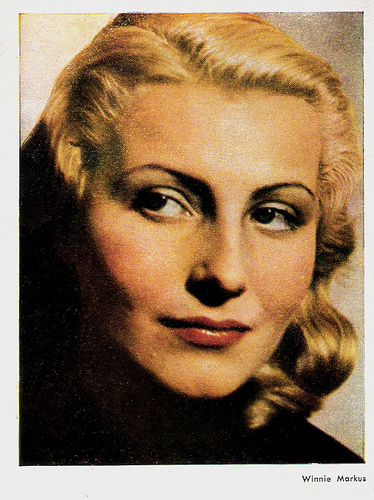
German postcard by Verlag und Druckerei Erwin Preuss, no. 17. Photo: Charlott Serda.
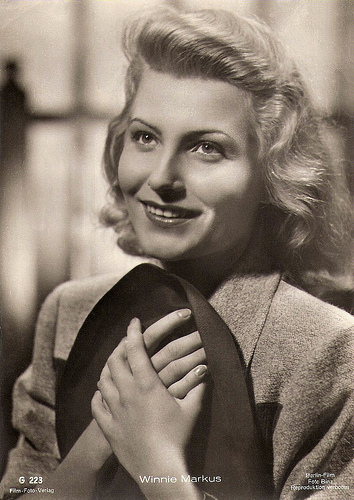
German postcard by Film-Foto-Verlag, no. G 223, 1941-1944. Photo: Berlin-Film / Foto Binz.
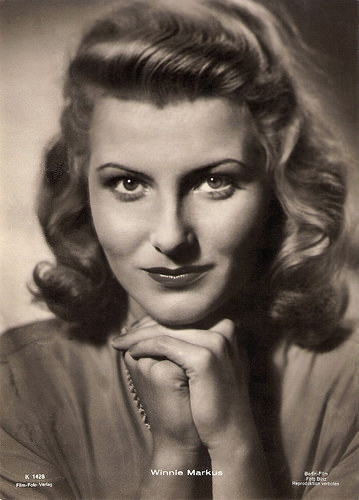
Big German card by Film-Foto-Verlag, no. K 1428, 1941-1944. Photo: Berlin-Film / Binz.
Mozart
Winnie Maria Eveline Markus was born in Prague, Czechoslovakia (now Czech Republic), in 1921. Her family belonged to the German population that remained in Czechoslovakia after the collapse of the Austria-Hungarian Dual Monarchy.
She lived till her 14th year in Prague, where her father worked as an export merchant. At 16, she went to Vienna to be trained at the Max Reinhardt Seminar.
After finishing her training, Markus made her stage debut as an elfin in William Shakespeare's Sommernachtstraum (A Midsummer Night's Dream) at the Theater in der Josefstadt in Vienna in 1939.
Soon she made a name for herself on the Viennese stage. Till 1945 she was engaged at the Theater in der Josefstadt, later followed engagements in Berlin and in Munich.
Her film debut was a small part in Mutterliebe/Mother Love (Gustav Ucicky, 1939) featuring Käthe Dorsch .
That same year, she played her first lead role in the adventure film Brand im Ozean/Fire in the Ocean (Günther Rittau, 1939) opposite Hans Söhnker and René Deltgen.
During the period of the Third Reich, she starred in 25 Ufa films, including Das alte Lied/The Old Song (Fritz Peter Buch, 1945), based on a novel by Theodor Fontane and filmed in Amsterdam and The Hague.
In the biography Wen die Götter lieben/Whom The Gods Love (Karl Hartl, 1942), she played Konstanze, the wife of Wolfgang Amadeus Mozart ( Hans Holt ). But the film was shelved, unfinished when the war ended.
After the war producer Abrasha Haimson bought the rights, hired director Frank Wisbar and filmed new scenes to finish the picture. In 1948, he released it as a new film, The Mozart Story.
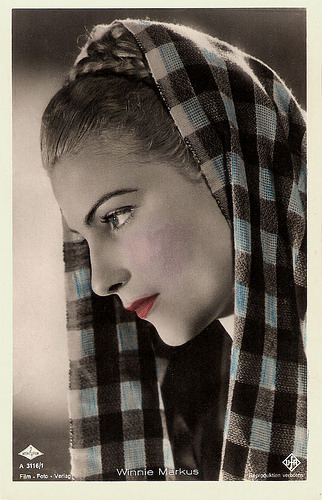
German postcard by Film-Foto-Verlag, no. A 3116/1, 1941-1944. Photo: Wien-Film / Ufa.
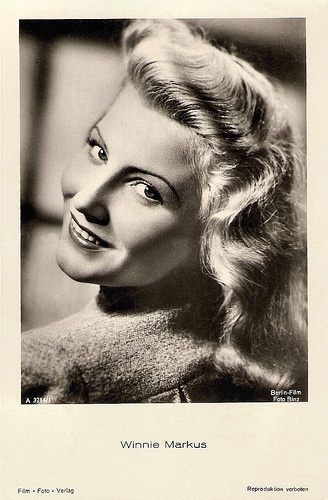
German postcard by Film-Foto-Verlag, no. A 3714/1, 1941-1944. Photo: Binz / Berlin-Film.
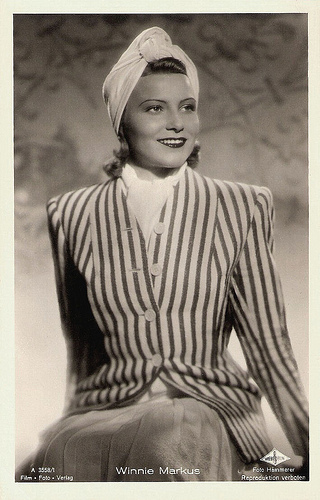
German postcard by Film-Foto-Verlag, no. A 3558/1, 1941-1944. Photo: Hämmerer.
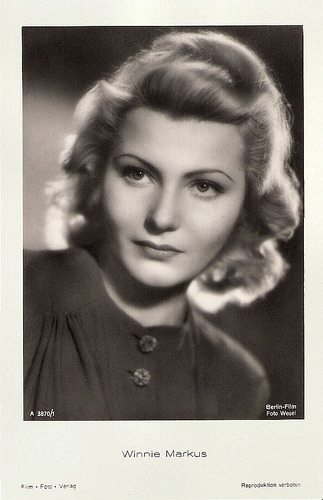
German postcard by Film-Foto-Verlag, no. A 3870/1, 1941-1944. Photo: Berlin-Film / Wesel.
Anti-Nazi films
Despite her past as an Ufa star, Winnie Markus could go on playing after the war in many stage plays and films, even in such anti-Nazi films as In jenen Tagen/In Those Days (Helmut Käutner, 1947), Zwischen gestern und morgen/Between Yesterday and Tomorrow (Harald Braun, 1947) with Hildegard Knef , and Morituri (Eugen York, 1948) with Walter Richter and Lotte Koch .
These Trümmerfilme (German Rubble films) examine the issues of collective guilt and future rebuilding. They were made directly after World War II and showed the impact of the ravages of the war on the countries at the centre of battle. Their style is characterized by its use of location exteriors among the 'rubble' of bombed-down cities to bring the gritty, depressing reality of the lives of the war survivors.
With Rudolf Prack , Markus became one of the most pretty pairs of the Heimatfilm genre during the 1950s. Their films together included Kaiserwalzer/The Emperor Waltz (Franz Antel, 1953) in which she played a beautiful teacher who falls in love with the dashing Archduke Ludwig.
Markus' other well-known films are the crime thriller Teufel in Seide/Devil in Silk (Rolf Hansen, 1956), Der Priester und das Mädchen/The Priest and the Girl (Gustav Ucicky, 1958) and Was eine Frau in Frühling träumt/What Women Dream of in Springtime (Erik Ode, Arthur Maria Rabenalt, 1959).
Her co-stars were actors like Curd Jürgens , O.W. Fischer and Paul Hubschmid .
She married twice. In 1946 she wed the Berlin hotel owner Heinz Zellermayer. Their son Alexander was killed in a traffic accident in 1982.
In 1959 she married contractor Aldi Vogel. Their daughter Diana Winnie later also became an actress.
After the birth of Diana in 1961, Markus retired as an actress. The following decades, she regularly represented her husband in his imperium, but after the collapse of his contracting firm she made her come-back as an actress in 1980.
Markus was still popular and in demand, and worked often for TV. In 1986 the German film world awarded her with the Filmband in Gold for her entire career and in 1988 she was awarded with the Bundesfilmkreuz.
In 2002 Winnie Markus died from a lung infection in Munich, Germany.
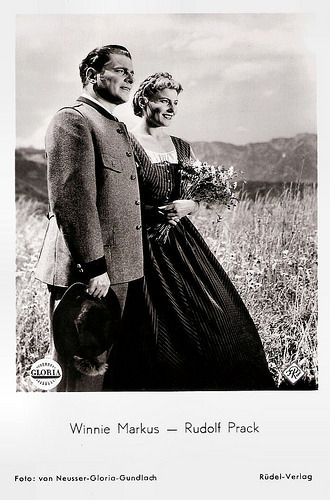
German postcard by Rüdel-Verlag, Hamburg-Bergedorff, no. 607. Photo: Von Neusser / Gloria / Gundlach. Publicity still for Kaiserwalzer/The Emperor Waltz (Franz Antel, 1953).
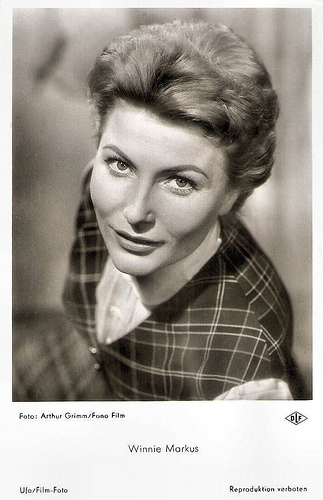
German postcard by Ufa, Berlin-Tempelhof, no. FK 1983. Photo: Arthur Grimm / Fono Film / DLF. Publicity still for Teufel in Seide/Devil in Silk (Rolf Hansen, 1956).
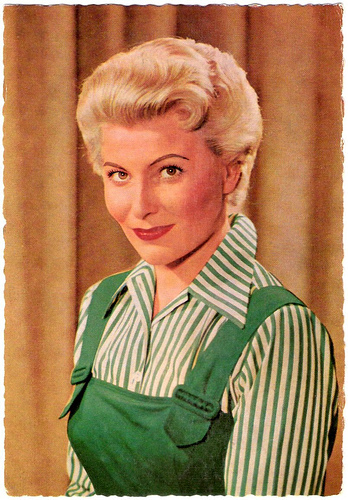
German postcard by WS-Druck, Wanne-Eickel, no. F 39. Photo: Bayer.
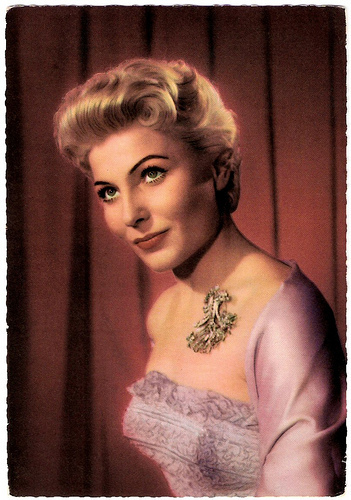
German postcard by ISV, no. C 6. Photo: Gloria / Bayer.
Sources: Ruud van Capelleveen (Absofacts2), Stephanie D'heil (Steffi-line - German), Winnie Markus.de (German), Wikipedia (German and English), and .

German postcard by Verlag und Druckerei Erwin Preuss, no. 17. Photo: Charlott Serda.

German postcard by Film-Foto-Verlag, no. G 223, 1941-1944. Photo: Berlin-Film / Foto Binz.

Big German card by Film-Foto-Verlag, no. K 1428, 1941-1944. Photo: Berlin-Film / Binz.
Mozart
Winnie Maria Eveline Markus was born in Prague, Czechoslovakia (now Czech Republic), in 1921. Her family belonged to the German population that remained in Czechoslovakia after the collapse of the Austria-Hungarian Dual Monarchy.
She lived till her 14th year in Prague, where her father worked as an export merchant. At 16, she went to Vienna to be trained at the Max Reinhardt Seminar.
After finishing her training, Markus made her stage debut as an elfin in William Shakespeare's Sommernachtstraum (A Midsummer Night's Dream) at the Theater in der Josefstadt in Vienna in 1939.
Soon she made a name for herself on the Viennese stage. Till 1945 she was engaged at the Theater in der Josefstadt, later followed engagements in Berlin and in Munich.
Her film debut was a small part in Mutterliebe/Mother Love (Gustav Ucicky, 1939) featuring Käthe Dorsch .
That same year, she played her first lead role in the adventure film Brand im Ozean/Fire in the Ocean (Günther Rittau, 1939) opposite Hans Söhnker and René Deltgen.
During the period of the Third Reich, she starred in 25 Ufa films, including Das alte Lied/The Old Song (Fritz Peter Buch, 1945), based on a novel by Theodor Fontane and filmed in Amsterdam and The Hague.
In the biography Wen die Götter lieben/Whom The Gods Love (Karl Hartl, 1942), she played Konstanze, the wife of Wolfgang Amadeus Mozart ( Hans Holt ). But the film was shelved, unfinished when the war ended.
After the war producer Abrasha Haimson bought the rights, hired director Frank Wisbar and filmed new scenes to finish the picture. In 1948, he released it as a new film, The Mozart Story.

German postcard by Film-Foto-Verlag, no. A 3116/1, 1941-1944. Photo: Wien-Film / Ufa.

German postcard by Film-Foto-Verlag, no. A 3714/1, 1941-1944. Photo: Binz / Berlin-Film.

German postcard by Film-Foto-Verlag, no. A 3558/1, 1941-1944. Photo: Hämmerer.

German postcard by Film-Foto-Verlag, no. A 3870/1, 1941-1944. Photo: Berlin-Film / Wesel.
Anti-Nazi films
Despite her past as an Ufa star, Winnie Markus could go on playing after the war in many stage plays and films, even in such anti-Nazi films as In jenen Tagen/In Those Days (Helmut Käutner, 1947), Zwischen gestern und morgen/Between Yesterday and Tomorrow (Harald Braun, 1947) with Hildegard Knef , and Morituri (Eugen York, 1948) with Walter Richter and Lotte Koch .
These Trümmerfilme (German Rubble films) examine the issues of collective guilt and future rebuilding. They were made directly after World War II and showed the impact of the ravages of the war on the countries at the centre of battle. Their style is characterized by its use of location exteriors among the 'rubble' of bombed-down cities to bring the gritty, depressing reality of the lives of the war survivors.
With Rudolf Prack , Markus became one of the most pretty pairs of the Heimatfilm genre during the 1950s. Their films together included Kaiserwalzer/The Emperor Waltz (Franz Antel, 1953) in which she played a beautiful teacher who falls in love with the dashing Archduke Ludwig.
Markus' other well-known films are the crime thriller Teufel in Seide/Devil in Silk (Rolf Hansen, 1956), Der Priester und das Mädchen/The Priest and the Girl (Gustav Ucicky, 1958) and Was eine Frau in Frühling träumt/What Women Dream of in Springtime (Erik Ode, Arthur Maria Rabenalt, 1959).
Her co-stars were actors like Curd Jürgens , O.W. Fischer and Paul Hubschmid .
She married twice. In 1946 she wed the Berlin hotel owner Heinz Zellermayer. Their son Alexander was killed in a traffic accident in 1982.
In 1959 she married contractor Aldi Vogel. Their daughter Diana Winnie later also became an actress.
After the birth of Diana in 1961, Markus retired as an actress. The following decades, she regularly represented her husband in his imperium, but after the collapse of his contracting firm she made her come-back as an actress in 1980.
Markus was still popular and in demand, and worked often for TV. In 1986 the German film world awarded her with the Filmband in Gold for her entire career and in 1988 she was awarded with the Bundesfilmkreuz.
In 2002 Winnie Markus died from a lung infection in Munich, Germany.

German postcard by Rüdel-Verlag, Hamburg-Bergedorff, no. 607. Photo: Von Neusser / Gloria / Gundlach. Publicity still for Kaiserwalzer/The Emperor Waltz (Franz Antel, 1953).

German postcard by Ufa, Berlin-Tempelhof, no. FK 1983. Photo: Arthur Grimm / Fono Film / DLF. Publicity still for Teufel in Seide/Devil in Silk (Rolf Hansen, 1956).

German postcard by WS-Druck, Wanne-Eickel, no. F 39. Photo: Bayer.

German postcard by ISV, no. C 6. Photo: Gloria / Bayer.
Sources: Ruud van Capelleveen (Absofacts2), Stephanie D'heil (Steffi-line - German), Winnie Markus.de (German), Wikipedia (German and English), and .
Published on October 19, 2014 23:00
October 18, 2014
Peppino De Filippo
Italian comic actor Peppino De Filippo (1903-1980) was a star of theatre, television and cinema in his country. He started his career on stage with his brother Eduardo and their sister Titina. In the 1950s and 1960s he became the partner of Totó in very popular comedy films and he appeared in two classics by Federico Fellini.
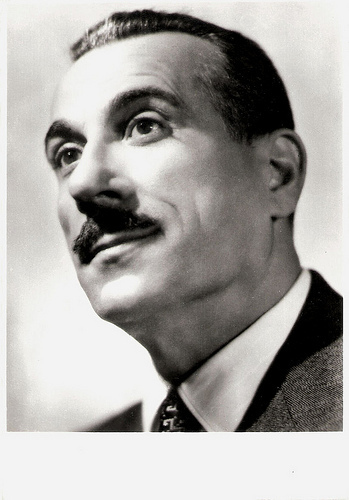
Italian postcard in the Hobby series by Bromostampa, Milano.
Own brand of comedy
Peppino De Filippo was born Giuseppe De Filippo in Naples, Italy in 1893. He came from a typical stage family. His father was the playwright Eduardo Scarpetta and his mother Luisa De Filippo. His brother was actor and dramatist Eduardo De Filippo and his sister actress Titina De Filippo. His half-brother were the actors Vincenzo Scarpetta, Eduardo Passarelli and Pasquale De Filippo.
Peppino made his stage debut at the age of six in Scarpetta's play Miseria e Nobilta. He studied the piano and went away to college for two years.
During WWI, back in Naples, he joined Scarpetta's company Molinari, and it was here that he met Totò. At 22, he joined the company of Salvatore De Muto, but had to return to the Scarpetta company after his estranged father, Eduardo Scarpetta, passed away.
Thus he, his brother Eduardo and their sister Titina, started to work together. After several attempts with different acting companies, they founded the Compagnia Teatro Umoristico: i De Filippo in 1931. The three staged their own brand of comedy and worked alongside the likes of Tina Pica, Carlo Pisacane, Agostino Salvietti and Giovanni Berardi. It was a very successful experience, featuring tours all over Italy, new comedies, enthusiastic ratings by critics, and sold out theatres.
Peppino De Filippo played in several Italian films. He made his screen debut in the French-Italian comedy Tre uomini in frack/Three Lucky Fools (Mario Bonnard, 1933) starring Tito Schipa and his brother Eduardo De Filippo . It was followed by Quei due/Those Two (Gennaro Righelli, 1935) with Eduardo and Assia Noris .
In campagna è caduta una stella/In the Country Fell a Star (Eduardo De Filippo, 1939) was based on a play written by Peppino De Filippo. Peppino and Eduardo play two peasant brothers who become obsessed with an American film starlet (Rosina Lawrence) who visits their small town and they neglect their fiancées.
However, in 1944, due to a controversy with his brother, Peppino abandoned their theatre company and their succesful cooperation ended definitively.
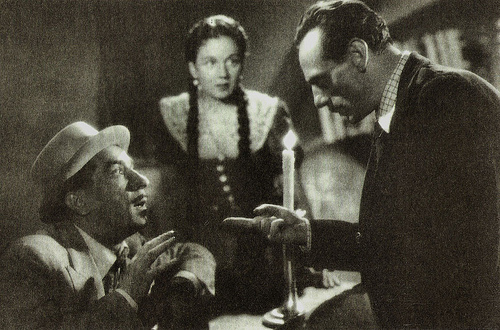
Italian postcard. Photo: publicity still of Casanova farebbe così/Casanova Would Do It That Way! (Carlo Ludovico Bragaglia, 1942) with Peppino and Eduardo de Filippo and Clelia Matania.
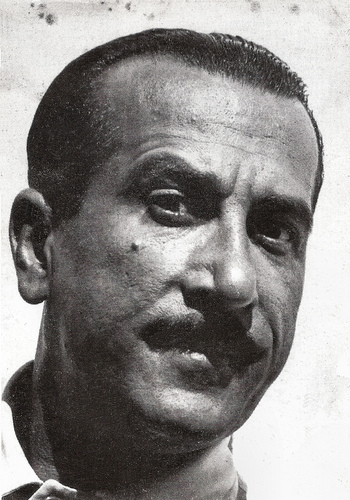
Italian postcard in the series Gli Artisti di Napoli.
Drink more milk
In 1945, Peppino De Filippo also separated from Adele Carloni, his wife of 16 years and he debuted with his new company with I Casi Sono Due at the Teatro Olimpia in Milan. The separation if his brother and sister would allow him to find his own stylistic footprint as an author, being easily distinguishable from Eduardo's: Peppino's comedies are usually easier and more elegant.
In 1950, he starred in the film comedy Luci del varietà/Variety Lights, produced and directed by Federico Fellini and Alberto Lattuada and co-starring Carla Del Poggio and Giulietta Masina . This bittersweet drama is about a beautiful but ambitious young woman who joins a group of second-rate theatrical performers on tour and inadvertently causes jealousy and emotional crises.
In Italy he is probably best remembered for his comedies with Totò , starting with Totò, Peppino e la malafemmina/Toto, Peppino, and the Hussy (Camillo Mastrocinque, 1956), Totò, Peppino e i fuorilegge/Totò, Peppino and the outlaws (Camillo Mastrocinque, 1956), and La banda degli onesti/The Band of Honest Men (Camillo Mastrocinque, 1956). These films obtained an outstanding success, and for Totò, Peppino e i fuorilegge, De Filippo was awarded with a Silver Ribbon for best supporting actor.
His other comedies include Signori, in carrozza!/Rome-Paris-Rome (Luigi Zampa, 1951) with Aldo Fabrizi, Un giorno in pretura/A Day in Court (Steno, 1954), La nonna Sabella/Oh! Sabella (Dino Risi, 1957) and Ferdinando I° re di Napoli/Ferdinand I, King of Naples (Gianni Franciolini, 1959).
From 1959 to 1969 he managed the Teatro delle Arti in Rome, and had worldwide success internationally during those years. Peppino repeatedly showed his extraordinary versatility; particularly noteworthy are his performance in Il Guardiano (The Caretaker) by Harold Pinter and as Harpagon in The Miser by Molière, where he proved to be a skillful actor whose ability had grown beyond Neapolitan comedies.
In the cinema, he worked again with Federico Fellini, at Le tentazioni del dottor Antonio/The Temptation of Dr Antonio, a hilarious segment for the anthology film Boccaccio '70 (1962). De Filippo plays a drooling middle-aged professor who is fed up with too much immorality. His anger knows no bounds when a provocative billboard of Anita Ekberg advertising ‘Drink more milk’ is put up opposite his residence. The image begins to haunt him and in his hallucinations he is pursued and captured by a giant form of the buxom Swedish star in a deserted Rome. At one point, his umbrella disappears between her breasts.
For a TV show, De Filippo invented the character Pappagone. He represented a humble servant of Commendatore Peppino De Filippo (the title of Commendatore is a public honour of the Italian Republic). He performed as a sort of usher, a typical character of the Neapolitan theatre, and coined many funny phrases and an own jargon, that would transform into popular sayings.
Peppino De Filippo died in Rome in 1980 due to a tumour. He was 76. He married three times, and his first wife Adele Carloni gave him his son Luigi De Filippo, who is successfully carrying on his father's work. He married his second wife, actress Lidia Martora, only a few hours before her death. In fact they have been partners for more than 25 years, but he was still married to his first wife (and divorce was not allowed in Italy at that time). In December 1970 divorce was sanctioned by law. De Filippo asked immediately for divorce, but Lidia Martora was already seriously ill, so their wedding was allowed - a tragic trick of chance - only on the same day in which she died. In 1977 he married Clelia Mangano, his business partner.
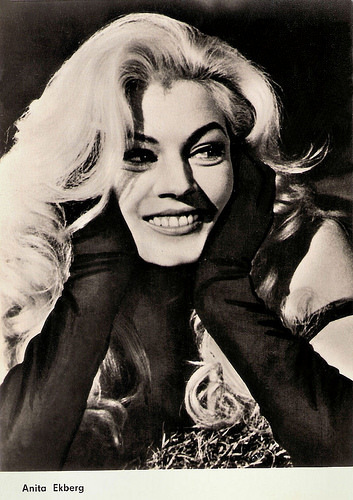
Anita Ekberg . East-German postcard by VEB Progress FilmVertrieb, Berlin, no. 2391, 1965. Photo: publicity still for Boccaccio '70 (Federico Fellini, 1962).
American theatrical trailer for Boccaccio '70 (1962). Source: Fandor Movie Trailers (YouTube).
Sources: (IMDb), Wikipedia (English and Italian), and .

Italian postcard in the Hobby series by Bromostampa, Milano.
Own brand of comedy
Peppino De Filippo was born Giuseppe De Filippo in Naples, Italy in 1893. He came from a typical stage family. His father was the playwright Eduardo Scarpetta and his mother Luisa De Filippo. His brother was actor and dramatist Eduardo De Filippo and his sister actress Titina De Filippo. His half-brother were the actors Vincenzo Scarpetta, Eduardo Passarelli and Pasquale De Filippo.
Peppino made his stage debut at the age of six in Scarpetta's play Miseria e Nobilta. He studied the piano and went away to college for two years.
During WWI, back in Naples, he joined Scarpetta's company Molinari, and it was here that he met Totò. At 22, he joined the company of Salvatore De Muto, but had to return to the Scarpetta company after his estranged father, Eduardo Scarpetta, passed away.
Thus he, his brother Eduardo and their sister Titina, started to work together. After several attempts with different acting companies, they founded the Compagnia Teatro Umoristico: i De Filippo in 1931. The three staged their own brand of comedy and worked alongside the likes of Tina Pica, Carlo Pisacane, Agostino Salvietti and Giovanni Berardi. It was a very successful experience, featuring tours all over Italy, new comedies, enthusiastic ratings by critics, and sold out theatres.
Peppino De Filippo played in several Italian films. He made his screen debut in the French-Italian comedy Tre uomini in frack/Three Lucky Fools (Mario Bonnard, 1933) starring Tito Schipa and his brother Eduardo De Filippo . It was followed by Quei due/Those Two (Gennaro Righelli, 1935) with Eduardo and Assia Noris .
In campagna è caduta una stella/In the Country Fell a Star (Eduardo De Filippo, 1939) was based on a play written by Peppino De Filippo. Peppino and Eduardo play two peasant brothers who become obsessed with an American film starlet (Rosina Lawrence) who visits their small town and they neglect their fiancées.
However, in 1944, due to a controversy with his brother, Peppino abandoned their theatre company and their succesful cooperation ended definitively.

Italian postcard. Photo: publicity still of Casanova farebbe così/Casanova Would Do It That Way! (Carlo Ludovico Bragaglia, 1942) with Peppino and Eduardo de Filippo and Clelia Matania.

Italian postcard in the series Gli Artisti di Napoli.
Drink more milk
In 1945, Peppino De Filippo also separated from Adele Carloni, his wife of 16 years and he debuted with his new company with I Casi Sono Due at the Teatro Olimpia in Milan. The separation if his brother and sister would allow him to find his own stylistic footprint as an author, being easily distinguishable from Eduardo's: Peppino's comedies are usually easier and more elegant.
In 1950, he starred in the film comedy Luci del varietà/Variety Lights, produced and directed by Federico Fellini and Alberto Lattuada and co-starring Carla Del Poggio and Giulietta Masina . This bittersweet drama is about a beautiful but ambitious young woman who joins a group of second-rate theatrical performers on tour and inadvertently causes jealousy and emotional crises.
In Italy he is probably best remembered for his comedies with Totò , starting with Totò, Peppino e la malafemmina/Toto, Peppino, and the Hussy (Camillo Mastrocinque, 1956), Totò, Peppino e i fuorilegge/Totò, Peppino and the outlaws (Camillo Mastrocinque, 1956), and La banda degli onesti/The Band of Honest Men (Camillo Mastrocinque, 1956). These films obtained an outstanding success, and for Totò, Peppino e i fuorilegge, De Filippo was awarded with a Silver Ribbon for best supporting actor.
His other comedies include Signori, in carrozza!/Rome-Paris-Rome (Luigi Zampa, 1951) with Aldo Fabrizi, Un giorno in pretura/A Day in Court (Steno, 1954), La nonna Sabella/Oh! Sabella (Dino Risi, 1957) and Ferdinando I° re di Napoli/Ferdinand I, King of Naples (Gianni Franciolini, 1959).
From 1959 to 1969 he managed the Teatro delle Arti in Rome, and had worldwide success internationally during those years. Peppino repeatedly showed his extraordinary versatility; particularly noteworthy are his performance in Il Guardiano (The Caretaker) by Harold Pinter and as Harpagon in The Miser by Molière, where he proved to be a skillful actor whose ability had grown beyond Neapolitan comedies.
In the cinema, he worked again with Federico Fellini, at Le tentazioni del dottor Antonio/The Temptation of Dr Antonio, a hilarious segment for the anthology film Boccaccio '70 (1962). De Filippo plays a drooling middle-aged professor who is fed up with too much immorality. His anger knows no bounds when a provocative billboard of Anita Ekberg advertising ‘Drink more milk’ is put up opposite his residence. The image begins to haunt him and in his hallucinations he is pursued and captured by a giant form of the buxom Swedish star in a deserted Rome. At one point, his umbrella disappears between her breasts.
For a TV show, De Filippo invented the character Pappagone. He represented a humble servant of Commendatore Peppino De Filippo (the title of Commendatore is a public honour of the Italian Republic). He performed as a sort of usher, a typical character of the Neapolitan theatre, and coined many funny phrases and an own jargon, that would transform into popular sayings.
Peppino De Filippo died in Rome in 1980 due to a tumour. He was 76. He married three times, and his first wife Adele Carloni gave him his son Luigi De Filippo, who is successfully carrying on his father's work. He married his second wife, actress Lidia Martora, only a few hours before her death. In fact they have been partners for more than 25 years, but he was still married to his first wife (and divorce was not allowed in Italy at that time). In December 1970 divorce was sanctioned by law. De Filippo asked immediately for divorce, but Lidia Martora was already seriously ill, so their wedding was allowed - a tragic trick of chance - only on the same day in which she died. In 1977 he married Clelia Mangano, his business partner.

Anita Ekberg . East-German postcard by VEB Progress FilmVertrieb, Berlin, no. 2391, 1965. Photo: publicity still for Boccaccio '70 (Federico Fellini, 1962).
American theatrical trailer for Boccaccio '70 (1962). Source: Fandor Movie Trailers (YouTube).
Sources: (IMDb), Wikipedia (English and Italian), and .
Published on October 18, 2014 23:00
October 17, 2014
Le Bossu (1925)
Today's film special is about Le Bossu/The Hunchback (1925), a French 'swashbuckler' directed by Jean Kemm. This silent film was the third of at least twelve screen adaptations of the popular novel Le Bossu by author Paul Féval.
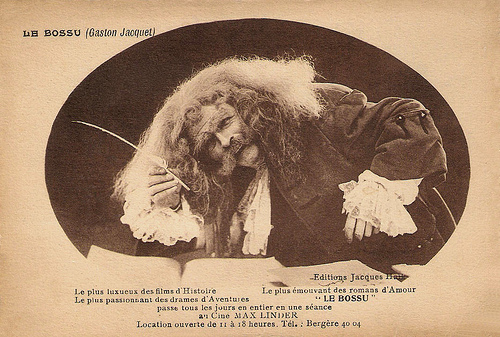
Gaston Jacquet in Le Bossu (1925). French postcard by Films Jacques Haïk. Photo: Combier Mâcon.
Swashbuckler Novel
Paul Féval's historical adventure novel Le Bossu was first published in serial parts in Paris in 1858.
The novel is one of a number of works such as Alexandre Dumas’ The Three Musketeers (1844) which helped define the genre of ‘swashbuckler’ novel, known in French as a ‘roman de cape et d'épée’.
Féval’s son, Paul Féval Fils borrowed his father's hero Chevalier Henri de Lagardère for his own series of Lagardère novels. For the film, he also co-wrote the scenario.
The story deals with the wealthy aristocrat De Lagardère (played by Gaston Jacquet ), who wants to avenge the death of his friend the Duc de Nevers (Jean Lorette).
The Duke was killed in a treacherous duel by the Prince of Gonzague ( Marcel Vibert ) many years ago. The Prince was jealous of the other man's riches, and after killing him, Gonzague also married de Nevers’ widow, Aurore ( Claude France ).
De Lagardère steals Irène, the child of Nevers and Aurore, and several years after, he returns pretending to be the deformed hunchback of the Rue Quincampoix. He unmasks Gonzague and holds Irène's (Nilda Duplessy) hand in return.
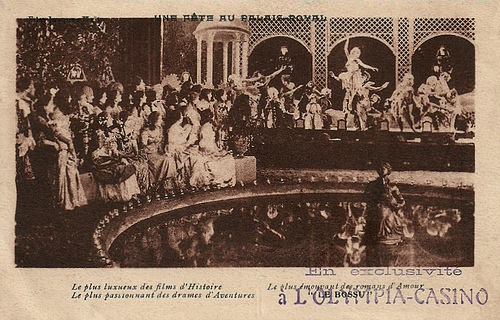
French postcard by Films Jacques Haïk. Photo: Combier Mâcon. Caption: 'Une fête au Palais-Royal'. (A party at the Royal Palace)
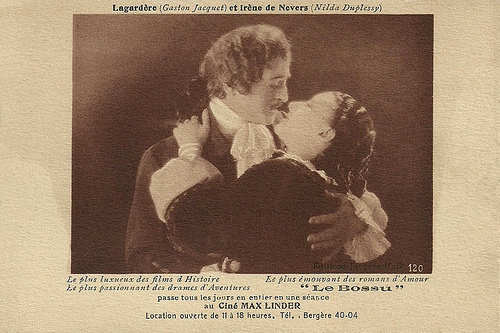
Gaston Jacquet as Lagardère and Nilda Duplessy as Irène de Nevers in Le Bossu (1925). French postcard by Films Jacques Haïk, no. 120. Photo: Combier Mâcon.
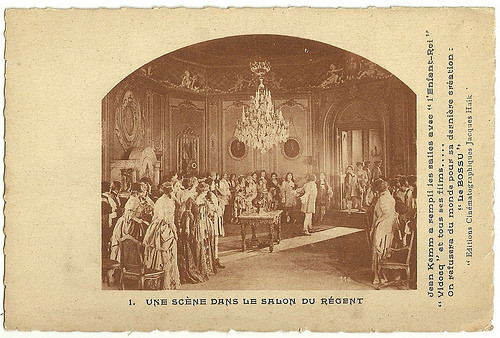
French postcard by Editions Cinématographiques Jacques Haïk, no. 1. Photo: publicity still for Le Bossu ou le Petit Parisien (Jean Kemm, 1925). Caption: "Une scène dans le salon du regent" (Scene in the Salon of the Regent).
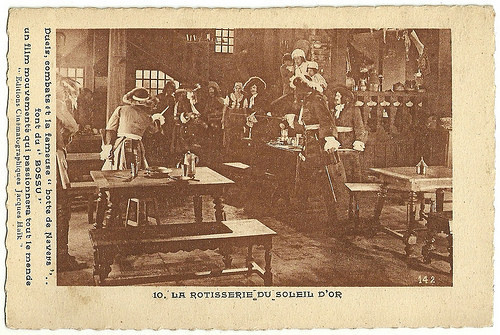
French postcard by Editions Cinématographiques Jacques Haïk, no. 10. Photo: publicity still for Le Bossu ou le Petit Parisien (Jean Kemm, 1925). Caption: "The Rotisserie du Soleil d'Or" (The Grill of the Golden Sun).
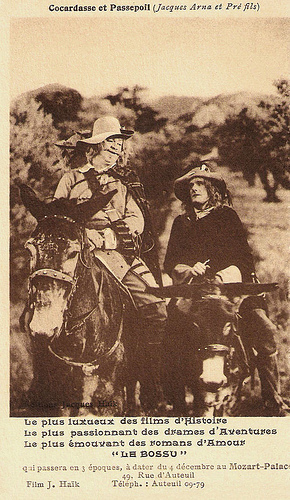
French postcard by Films Jacques Haïk. Photo: Combier Mâcon. Publicity still for Le Bossu ou le Petit Parisien (Jean Kemm, 1925) with Jacques Arna aka Arna and Louis Pré fils as the comic sidekicks Cocardasse and Passepoil. Louis Pré fils (1884-1970) was a French actor, who acted mainly in supporting parts in French cinema, during the 1920s and 1930s. He peaked in the early 1920s in such films als Les trois mousquetaires/The Three Musketeers (Henri Diamant-Berger, 1921), Vingt ans après/Twenty Years Later (Henri Diamant-Berger, 1922) and Le Bossu (1925). Jacques Arna only acted in a handful of French silent films, including Vingt ans après/Twenty Years Later (Henri Diamant-Berger, 1922) , Le Bossu (1925) and La passion de Jeanne d'Arc/The Passion of Joan of Arc (Carl Theodor Dreyer, 1928). Arna was also an historian, a graphologist and an opera singer.
French Resistance
Le Bossu (1925) was probably the first production of French film pioneer Jacques Haïk (1883–1950).
Haïk had been an active French film distributor during the early sound era. He had introduced the Charlie Chaplin films in France and was the inventor of his French name Charlot.
He later created the famous Paris venue Olympia, and built film studios in the Paris suburbs of Courbevoie and La Garenne. He also opened several prestige cinemas in France, including Le Grand Rex (1932) in Paris, the biggest cinema of Europe.
The postcards that were produced to promote Le Bossu show that the film was presented in Haïk's Olympia ('in exclusivity'), but also in the Ciné Max Linder and the Mozart-Palace, both in Paris.
Ciné Max Linder opened in 1912 as Kosmorama. In 1914 actor-director Max Linder bought the cinema and renamed it after himself. Today, the cinema still exists, though it has been completely modernized.
The Mozart-Palace existed between 1913 and 1954. It is now a supermarket.
After Le Bossu, Jacques Haïk would continue to produce dozens of French films until the Second World War.
During the war, the Jewish and anti-Nazi Haïk joined the Forces Françaises Libres (French resistance) and became its representative in the Arab world. After the war he returned to France and tried to recover his property and films that had all been confiscated by the Germans. Five years later he died.
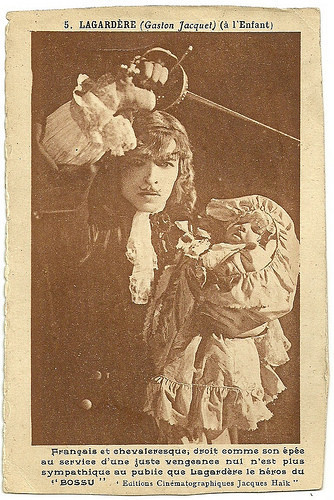
French postcard by Editions Cinématographiques Jacques Haïk, no. 5. Photo: publicity still for Le Bossu ou le Petit Parisien (Jean Kemm, 1925). Caption: "Lagardère {à L'Enfant" ((Young) Lagardère).
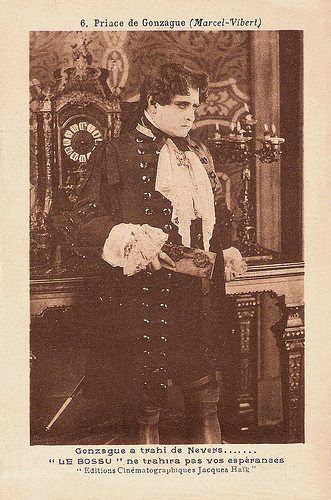
French postcard by Editions Cinématographiques Jacques Haïk, no. 6. Photo: publicity still of Marcel Vibert as the Prince de Gonzague. Caption: 'Gonzague a trahi de Nevers... Le Bossu ne trahira vos espérances'. (Gonzague has betrayed de Nevers, but Le Bossu will not betray your expectations.)
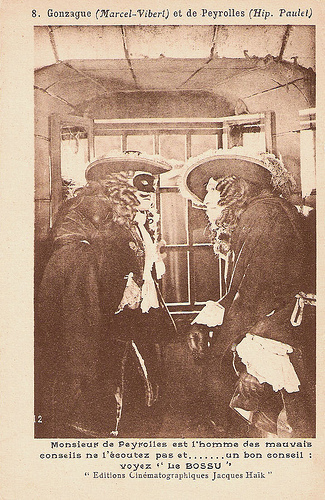
French postcard by Editions Cinématographiques Jacques Haïk, no. 8. Photo: publicity still of Marcel Vibert as the Prince de Gonzague and Hypolyte Paulet as de Peyrolles. Caption: 'Monsieur de Peyrolles est l'homme des mauvais conseils ne l'écoutez pas et ... un bon conseil: voyez Le Bossu'. (Mr. de Peyrolles is the man of bad advice. Don't listen to him and ... a good advice: see Le Bossu.)
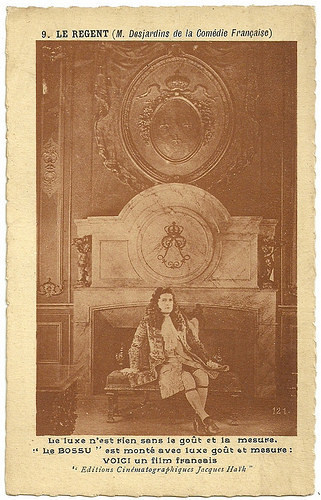
French postcard by Editions Cinématographiques Jacques Haïkm no. 9. Le Bossu ou le Petit Parisien (Jean Kemm, 1925) with Maxime Desjardins as Le Régent. Caption: "Le luxe n'est rien sans le goût et la mesure. 'Le Bossu' est monté avec goût et la mesure: voici un film Français." (Luxury is nothing without the taste and measure. Le Bossu is mounted with taste and measurement: this is a French film.)
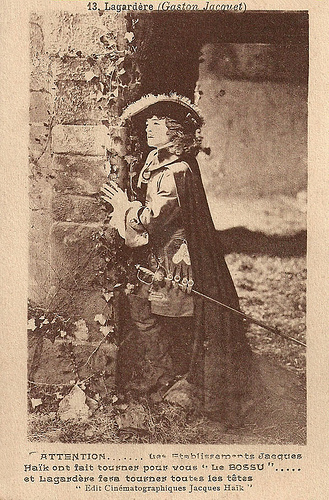
French postcard by Editions Cinématographiques Jacques Haïk, no. 13. Photo: publicity still of Lagardère ( Gaston Jacquet ). Caption: 'Les Etablissements Jacques Haïk ont fait tourner pour vous Le Bossu... et Lagardère fera tourner toutes les têtes.' (Les Etablissements Jacques Haïk will 'turn' (film) Le Bossu for you... and Lagardère will turn everybody's head.)
Film Versions
Le Bossu/The Hunchback (1925) was not the first screen adaptation of Féval’s adventure novel, and not the last. The novel was filmed more than 10 times.
The original film version was the silent short Le Bossu (André Heuzé, 1912) starring Henry Krauss and Yvette Andréyor .
Krauss repeated his interpretation in Le Bossu (1923) opposite Claude Mérelle and Edouard de Max . Ten years after the original silent version, René Sti made the first sound version Le Bossu (1935) with Robert Vidalin as Henri de Lagardère, Josseline Gaël as Aurore de Caylus and Samson Fainsilber as Monsieur de Peyrolles.
In 1943 followed a Mexican version El jorobado (Jaime Salvador, 1943) and a year later a new French version Le Bossu (Jean Delannoy, 1944) starring Pierre Blanchard as Henri de Lagardère.
In 1955 came another Latin-American version, the Argentine production El juramento de Lagardere (León Klimovsky, 1955).
Probably the best known version is Le Bossu (André Hunebelle, 1959) starring Jean Marais and Bourvil .
The mini-series Lagardère (Jean-Pierre Decourt, 1967) featured Jean Piat, Sacha Pitoëff and Jacques Dufilho.
Thirty years later Lagardère returned to the cinema in the lush Le Bossu/On Guard (1997, Philippe de Broca). Among the cast were such French stars as Daniel Auteuil as Lagardère, Fabrice Luchini as Gonzague, and Vincent Perez as De Nevers.
The most recent adaptation was the TV film Lagardère (Henri Helman, 2004) with Bruno Wolkowitch.
Trailer of Le Bossu (André Hunebelle, 1959). Source: Ibena65 (YouTube).
Trailer of Le Bossu ( Philippe de Broca, 1997). Source: Cinemaetcie (YouTube).
Sources: Les indépendants du premier siècle (French), Wikipedia and IMDb.

Gaston Jacquet in Le Bossu (1925). French postcard by Films Jacques Haïk. Photo: Combier Mâcon.
Swashbuckler Novel
Paul Féval's historical adventure novel Le Bossu was first published in serial parts in Paris in 1858.
The novel is one of a number of works such as Alexandre Dumas’ The Three Musketeers (1844) which helped define the genre of ‘swashbuckler’ novel, known in French as a ‘roman de cape et d'épée’.
Féval’s son, Paul Féval Fils borrowed his father's hero Chevalier Henri de Lagardère for his own series of Lagardère novels. For the film, he also co-wrote the scenario.
The story deals with the wealthy aristocrat De Lagardère (played by Gaston Jacquet ), who wants to avenge the death of his friend the Duc de Nevers (Jean Lorette).
The Duke was killed in a treacherous duel by the Prince of Gonzague ( Marcel Vibert ) many years ago. The Prince was jealous of the other man's riches, and after killing him, Gonzague also married de Nevers’ widow, Aurore ( Claude France ).
De Lagardère steals Irène, the child of Nevers and Aurore, and several years after, he returns pretending to be the deformed hunchback of the Rue Quincampoix. He unmasks Gonzague and holds Irène's (Nilda Duplessy) hand in return.

French postcard by Films Jacques Haïk. Photo: Combier Mâcon. Caption: 'Une fête au Palais-Royal'. (A party at the Royal Palace)

Gaston Jacquet as Lagardère and Nilda Duplessy as Irène de Nevers in Le Bossu (1925). French postcard by Films Jacques Haïk, no. 120. Photo: Combier Mâcon.

French postcard by Editions Cinématographiques Jacques Haïk, no. 1. Photo: publicity still for Le Bossu ou le Petit Parisien (Jean Kemm, 1925). Caption: "Une scène dans le salon du regent" (Scene in the Salon of the Regent).

French postcard by Editions Cinématographiques Jacques Haïk, no. 10. Photo: publicity still for Le Bossu ou le Petit Parisien (Jean Kemm, 1925). Caption: "The Rotisserie du Soleil d'Or" (The Grill of the Golden Sun).

French postcard by Films Jacques Haïk. Photo: Combier Mâcon. Publicity still for Le Bossu ou le Petit Parisien (Jean Kemm, 1925) with Jacques Arna aka Arna and Louis Pré fils as the comic sidekicks Cocardasse and Passepoil. Louis Pré fils (1884-1970) was a French actor, who acted mainly in supporting parts in French cinema, during the 1920s and 1930s. He peaked in the early 1920s in such films als Les trois mousquetaires/The Three Musketeers (Henri Diamant-Berger, 1921), Vingt ans après/Twenty Years Later (Henri Diamant-Berger, 1922) and Le Bossu (1925). Jacques Arna only acted in a handful of French silent films, including Vingt ans après/Twenty Years Later (Henri Diamant-Berger, 1922) , Le Bossu (1925) and La passion de Jeanne d'Arc/The Passion of Joan of Arc (Carl Theodor Dreyer, 1928). Arna was also an historian, a graphologist and an opera singer.
French Resistance
Le Bossu (1925) was probably the first production of French film pioneer Jacques Haïk (1883–1950).
Haïk had been an active French film distributor during the early sound era. He had introduced the Charlie Chaplin films in France and was the inventor of his French name Charlot.
He later created the famous Paris venue Olympia, and built film studios in the Paris suburbs of Courbevoie and La Garenne. He also opened several prestige cinemas in France, including Le Grand Rex (1932) in Paris, the biggest cinema of Europe.
The postcards that were produced to promote Le Bossu show that the film was presented in Haïk's Olympia ('in exclusivity'), but also in the Ciné Max Linder and the Mozart-Palace, both in Paris.
Ciné Max Linder opened in 1912 as Kosmorama. In 1914 actor-director Max Linder bought the cinema and renamed it after himself. Today, the cinema still exists, though it has been completely modernized.
The Mozart-Palace existed between 1913 and 1954. It is now a supermarket.
After Le Bossu, Jacques Haïk would continue to produce dozens of French films until the Second World War.
During the war, the Jewish and anti-Nazi Haïk joined the Forces Françaises Libres (French resistance) and became its representative in the Arab world. After the war he returned to France and tried to recover his property and films that had all been confiscated by the Germans. Five years later he died.

French postcard by Editions Cinématographiques Jacques Haïk, no. 5. Photo: publicity still for Le Bossu ou le Petit Parisien (Jean Kemm, 1925). Caption: "Lagardère {à L'Enfant" ((Young) Lagardère).

French postcard by Editions Cinématographiques Jacques Haïk, no. 6. Photo: publicity still of Marcel Vibert as the Prince de Gonzague. Caption: 'Gonzague a trahi de Nevers... Le Bossu ne trahira vos espérances'. (Gonzague has betrayed de Nevers, but Le Bossu will not betray your expectations.)

French postcard by Editions Cinématographiques Jacques Haïk, no. 8. Photo: publicity still of Marcel Vibert as the Prince de Gonzague and Hypolyte Paulet as de Peyrolles. Caption: 'Monsieur de Peyrolles est l'homme des mauvais conseils ne l'écoutez pas et ... un bon conseil: voyez Le Bossu'. (Mr. de Peyrolles is the man of bad advice. Don't listen to him and ... a good advice: see Le Bossu.)

French postcard by Editions Cinématographiques Jacques Haïkm no. 9. Le Bossu ou le Petit Parisien (Jean Kemm, 1925) with Maxime Desjardins as Le Régent. Caption: "Le luxe n'est rien sans le goût et la mesure. 'Le Bossu' est monté avec goût et la mesure: voici un film Français." (Luxury is nothing without the taste and measure. Le Bossu is mounted with taste and measurement: this is a French film.)

French postcard by Editions Cinématographiques Jacques Haïk, no. 13. Photo: publicity still of Lagardère ( Gaston Jacquet ). Caption: 'Les Etablissements Jacques Haïk ont fait tourner pour vous Le Bossu... et Lagardère fera tourner toutes les têtes.' (Les Etablissements Jacques Haïk will 'turn' (film) Le Bossu for you... and Lagardère will turn everybody's head.)
Film Versions
Le Bossu/The Hunchback (1925) was not the first screen adaptation of Féval’s adventure novel, and not the last. The novel was filmed more than 10 times.
The original film version was the silent short Le Bossu (André Heuzé, 1912) starring Henry Krauss and Yvette Andréyor .
Krauss repeated his interpretation in Le Bossu (1923) opposite Claude Mérelle and Edouard de Max . Ten years after the original silent version, René Sti made the first sound version Le Bossu (1935) with Robert Vidalin as Henri de Lagardère, Josseline Gaël as Aurore de Caylus and Samson Fainsilber as Monsieur de Peyrolles.
In 1943 followed a Mexican version El jorobado (Jaime Salvador, 1943) and a year later a new French version Le Bossu (Jean Delannoy, 1944) starring Pierre Blanchard as Henri de Lagardère.
In 1955 came another Latin-American version, the Argentine production El juramento de Lagardere (León Klimovsky, 1955).
Probably the best known version is Le Bossu (André Hunebelle, 1959) starring Jean Marais and Bourvil .
The mini-series Lagardère (Jean-Pierre Decourt, 1967) featured Jean Piat, Sacha Pitoëff and Jacques Dufilho.
Thirty years later Lagardère returned to the cinema in the lush Le Bossu/On Guard (1997, Philippe de Broca). Among the cast were such French stars as Daniel Auteuil as Lagardère, Fabrice Luchini as Gonzague, and Vincent Perez as De Nevers.
The most recent adaptation was the TV film Lagardère (Henri Helman, 2004) with Bruno Wolkowitch.
Trailer of Le Bossu (André Hunebelle, 1959). Source: Ibena65 (YouTube).
Trailer of Le Bossu ( Philippe de Broca, 1997). Source: Cinemaetcie (YouTube).
Sources: Les indépendants du premier siècle (French), Wikipedia and IMDb.
Published on October 17, 2014 23:00
October 16, 2014
Käthe Haack
Käthe Haack (1897-1986) was an extremely versatile German actress. Between 1915 and 1980 she portrayed a wide range of characters in some 230 films and television productions, often to rave reviews.
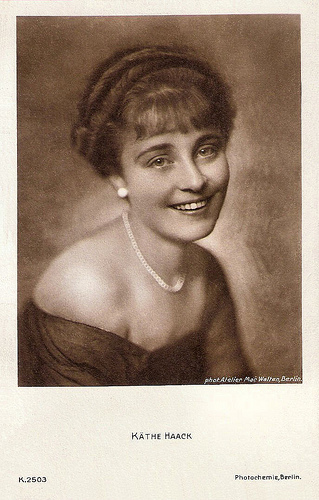
German postcard by Photochemie, Berlin, no. K. 2503. Photo: Phot. Atelier Walten, Berlin.
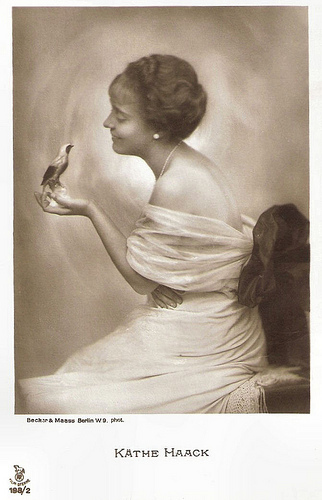
German postcard by Rotophot in the Film Sterne series, no. 198/2. Photo: Becker & Maass, Berlin.
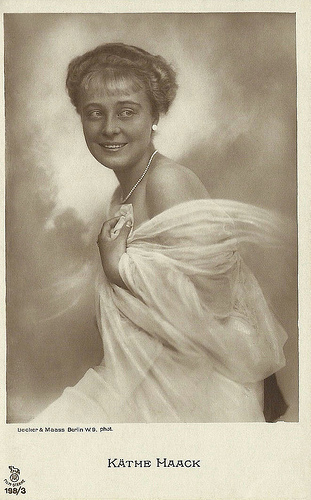
German postcard by Rotophot in the Film Sterne series, no. 198/3. Photo: Becker & Maass, Berlin. Collection: Didier Hanson.
Good-natured To Vicious
Käte Lisbeth Minna Sophie Isolde Haack was born in Berlin, Germany, in 1897. She was the daughter of cloth merchant Karl Wilhelm Paul Haack and his wife Sophie Margaret Haack, née Jahn.
After attending a private lyceum in Berlin-Charlottenburg, she took acting lessons with Seraphine Détschy and Hans Kaufmann. In 1914 she received her first engagement at the Stadttheater Göttingen (City Theater Goettingen).
From 1915 on she played most of the time in the theatres of Berlin. Her roles included Anni in Ferenc Molnár's Spiel im Schloss (Play in the Castle), Clara in the premiere of Der fröhliche Weinberg (The Merry Weinberg) in 1925, and Mayor Gülstorff in the premiere of Der Hauptmann von Köpenick (The Captain from Köpenick) at the Deutsche Theater in 1931, directed by Heinz Hilpert.
From 1935 to 1944 she worked at the Preußischen Staatstheater Berlin (Prussian State Theater in Berlin) under Gustaf Gründgens.
Already in 1915 she had her first film appearance in Pension Lampel (Max Mack, 1915) opposite Hanni Weisse . After a highly praised performance in Mack's Der Katzensteg/The Cat Walk (Max Mack, 1915), Haack further pursued her film career.
During the 1910s she portrayed a wide range from good-natured to vicious characters in such films as Das Tagebuch des Dr. Hart/The Diary of Dr. Hart (Paul Leni, 1916) opposite her later husband Heinrich Schroth, Die Hochzeit im Excentricclub/Marriage at the Excentricclub (Joe May, 1917) written by Fritz Lang, and in the title role of the detective film Die Ratte/The Rat (Harry Piel, Joe May, 1918) opposite Heinrich Schroth as Joe Deebs.
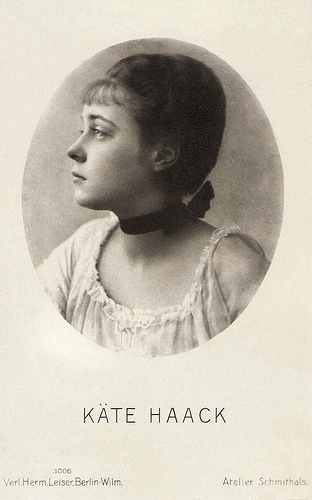
German postcard by Verlag Herm. Leiser, Berlin-Wilm., no. 3006. Photo: Atelier Schmithals.
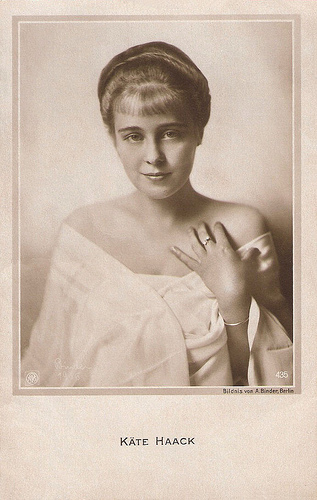
German postcard by Rotophot, no. 436, 1916. Photo: A. Binder, Berlin.
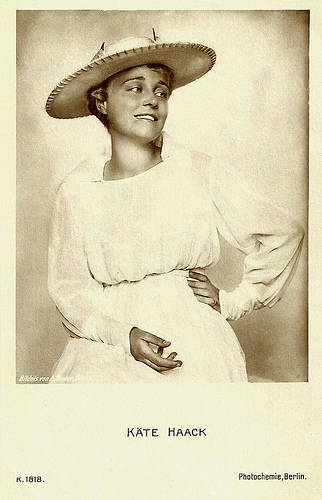
German postcard by Photochemie, Berlin, no. K. 1818. Photo: Alex Binder.
Rave Reviews
In the 1920s, Käthe Haack was more or less reduced to parts of dull bourgeois women or amiable housewives in such successful productions as Der tote Gast/The Dead Guest (Karl Freund, 1921), Hedda Gabler (Franz Eckstein, 1924) starring Asta Nielsen , and Der alte Fritz/The Old Fritz (Gerhard Lamprecht, 1927) with Otto Gebühr .
The extremely versatile actress received numerous role offers and could easily continue her career after the end of the silent era. She changed her image from a ‘young and street-smart girl’ to a wife and mother.
During the 1930s, Haack was one of the most successful and popular actresses. She appeared in box office hits like Berlin - Alexanderplatz (Phil Jutzi, 1931) starring Heinrich George , Emil und die Detektive/Emil and the Detectives (Gerhard Lamprecht, 1931) as Emil’s mother, Der Hauptmann von Köpenick/The Captain from Köpenick (Richard Oswald, 1931), and Pygmalion (Erich Engel, 1935) starring Jenny Jugo .
During the war period, she starred in elaborate large-scale productions like the biography Bismarck (Wolfgang Liebeneiner, 1940) and the monumental Münchhausen/The Adventures of Baron Munchhausen (Josef von Báky, 1943) starring Hans Albers.
After the Second World War II, she remained one of best-known and most successful actresses of the German cinema. She played in films ranging from melodramas like Herz der Welt/The Alfred Nobel Story (Harald Braun, 1952) to crime films like Dynamit in grüner Seide/Death and Diamonds (Harald Reinl, 1968) starring George Nader , and to comedies like Der letzte Fußgänger/The Last Pedestrian (Wilhelm Thiele, 1961) with Heinz Erhardt.
A type of role she often portrayed at the end of her career was the distinguished ‘Grande Dame’. For this role in Der Lord von Barmbeck/The Lord of Barmbeck (Ottokar Runze, 1973) and Grete Minde – Der Wald ist voller Wölfe/Grete Minde - The forest is full of wolves (Heide Genée, 1977), she received rave reviews.
She remained also successful as a theatre actress in Berlin. Important post-war stage roles were Mrs. Antrobus in Wir sind noch einmal davongekommen (We got away once more, 1946, Hebbel-Theater), Mrs. Higgins in My Fair Lady (1963, a tour with 1500 performances) and Louise Mask in Carl Sternheim's Der Snob (The Snob, 1966, Renaissance Theater).
In 1967 she was appointed ‘Berlin State Actress’ and in 1973 she was awarded the Filmband in Gold for her long and outstanding achievements in the German film industry. Haack published her memoirs under the title In Berlin und Anderswo (In Berlin and elsewhere) in 1971.
Käthe Haack died in 1986 in her hometown Berlin. Her daughter, Hannelore Schroth and her stepsons, Heinz Schroth aka Heinz Sailer and Carl-Heinz Schroth, were also well-known actors.
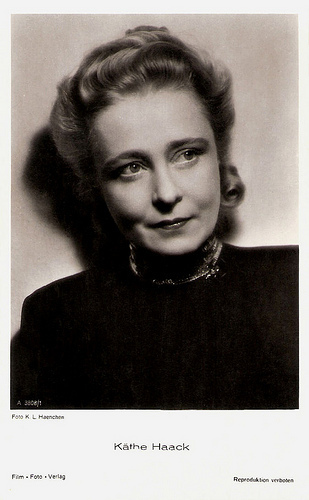
German postcard by Film-Foto-Verlag, no. A 3808/1, 1941-1944. Photo: K.L. Haenchen.
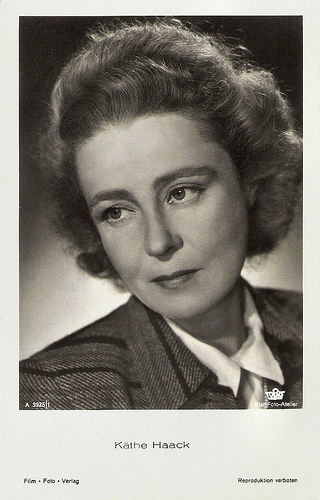
German postcard by Film-Foto-Verlag, no. A 3925/1, 1941-1944. Photo: Star-Foto-Atelier / Tobis.
Sources: Stephanie D’heil (Steffi-line) (German), Thomas Staedeli (Cyranos), Filmportal.de, Wikipedia (German), and .

German postcard by Photochemie, Berlin, no. K. 2503. Photo: Phot. Atelier Walten, Berlin.

German postcard by Rotophot in the Film Sterne series, no. 198/2. Photo: Becker & Maass, Berlin.

German postcard by Rotophot in the Film Sterne series, no. 198/3. Photo: Becker & Maass, Berlin. Collection: Didier Hanson.
Good-natured To Vicious
Käte Lisbeth Minna Sophie Isolde Haack was born in Berlin, Germany, in 1897. She was the daughter of cloth merchant Karl Wilhelm Paul Haack and his wife Sophie Margaret Haack, née Jahn.
After attending a private lyceum in Berlin-Charlottenburg, she took acting lessons with Seraphine Détschy and Hans Kaufmann. In 1914 she received her first engagement at the Stadttheater Göttingen (City Theater Goettingen).
From 1915 on she played most of the time in the theatres of Berlin. Her roles included Anni in Ferenc Molnár's Spiel im Schloss (Play in the Castle), Clara in the premiere of Der fröhliche Weinberg (The Merry Weinberg) in 1925, and Mayor Gülstorff in the premiere of Der Hauptmann von Köpenick (The Captain from Köpenick) at the Deutsche Theater in 1931, directed by Heinz Hilpert.
From 1935 to 1944 she worked at the Preußischen Staatstheater Berlin (Prussian State Theater in Berlin) under Gustaf Gründgens.
Already in 1915 she had her first film appearance in Pension Lampel (Max Mack, 1915) opposite Hanni Weisse . After a highly praised performance in Mack's Der Katzensteg/The Cat Walk (Max Mack, 1915), Haack further pursued her film career.
During the 1910s she portrayed a wide range from good-natured to vicious characters in such films as Das Tagebuch des Dr. Hart/The Diary of Dr. Hart (Paul Leni, 1916) opposite her later husband Heinrich Schroth, Die Hochzeit im Excentricclub/Marriage at the Excentricclub (Joe May, 1917) written by Fritz Lang, and in the title role of the detective film Die Ratte/The Rat (Harry Piel, Joe May, 1918) opposite Heinrich Schroth as Joe Deebs.

German postcard by Verlag Herm. Leiser, Berlin-Wilm., no. 3006. Photo: Atelier Schmithals.

German postcard by Rotophot, no. 436, 1916. Photo: A. Binder, Berlin.

German postcard by Photochemie, Berlin, no. K. 1818. Photo: Alex Binder.
Rave Reviews
In the 1920s, Käthe Haack was more or less reduced to parts of dull bourgeois women or amiable housewives in such successful productions as Der tote Gast/The Dead Guest (Karl Freund, 1921), Hedda Gabler (Franz Eckstein, 1924) starring Asta Nielsen , and Der alte Fritz/The Old Fritz (Gerhard Lamprecht, 1927) with Otto Gebühr .
The extremely versatile actress received numerous role offers and could easily continue her career after the end of the silent era. She changed her image from a ‘young and street-smart girl’ to a wife and mother.
During the 1930s, Haack was one of the most successful and popular actresses. She appeared in box office hits like Berlin - Alexanderplatz (Phil Jutzi, 1931) starring Heinrich George , Emil und die Detektive/Emil and the Detectives (Gerhard Lamprecht, 1931) as Emil’s mother, Der Hauptmann von Köpenick/The Captain from Köpenick (Richard Oswald, 1931), and Pygmalion (Erich Engel, 1935) starring Jenny Jugo .
During the war period, she starred in elaborate large-scale productions like the biography Bismarck (Wolfgang Liebeneiner, 1940) and the monumental Münchhausen/The Adventures of Baron Munchhausen (Josef von Báky, 1943) starring Hans Albers.
After the Second World War II, she remained one of best-known and most successful actresses of the German cinema. She played in films ranging from melodramas like Herz der Welt/The Alfred Nobel Story (Harald Braun, 1952) to crime films like Dynamit in grüner Seide/Death and Diamonds (Harald Reinl, 1968) starring George Nader , and to comedies like Der letzte Fußgänger/The Last Pedestrian (Wilhelm Thiele, 1961) with Heinz Erhardt.
A type of role she often portrayed at the end of her career was the distinguished ‘Grande Dame’. For this role in Der Lord von Barmbeck/The Lord of Barmbeck (Ottokar Runze, 1973) and Grete Minde – Der Wald ist voller Wölfe/Grete Minde - The forest is full of wolves (Heide Genée, 1977), she received rave reviews.
She remained also successful as a theatre actress in Berlin. Important post-war stage roles were Mrs. Antrobus in Wir sind noch einmal davongekommen (We got away once more, 1946, Hebbel-Theater), Mrs. Higgins in My Fair Lady (1963, a tour with 1500 performances) and Louise Mask in Carl Sternheim's Der Snob (The Snob, 1966, Renaissance Theater).
In 1967 she was appointed ‘Berlin State Actress’ and in 1973 she was awarded the Filmband in Gold for her long and outstanding achievements in the German film industry. Haack published her memoirs under the title In Berlin und Anderswo (In Berlin and elsewhere) in 1971.
Käthe Haack died in 1986 in her hometown Berlin. Her daughter, Hannelore Schroth and her stepsons, Heinz Schroth aka Heinz Sailer and Carl-Heinz Schroth, were also well-known actors.

German postcard by Film-Foto-Verlag, no. A 3808/1, 1941-1944. Photo: K.L. Haenchen.

German postcard by Film-Foto-Verlag, no. A 3925/1, 1941-1944. Photo: Star-Foto-Atelier / Tobis.
Sources: Stephanie D’heil (Steffi-line) (German), Thomas Staedeli (Cyranos), Filmportal.de, Wikipedia (German), and .
Published on October 16, 2014 23:00
October 15, 2014
Jan Kiepura
Polish actor and singer Jan Kiepura (1902-1966) was one of the grand tenors of the 20th century. With his handsome smile he also became a popular star of the early German sound film. Solo and together with Marta Eggerth, he starred in many popular film operettas of the 1930s, often produced in multiple-language versions.
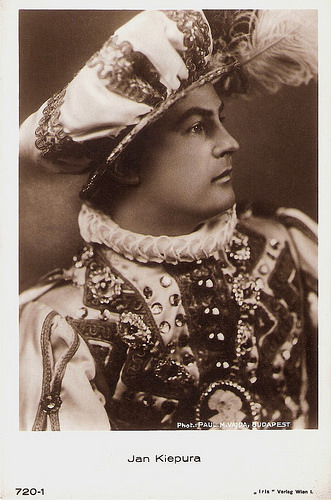
Austrian postcard by Iris-Verlag, Wien, no. 720-1. Photo: Paul M. Vajda, Budapest.
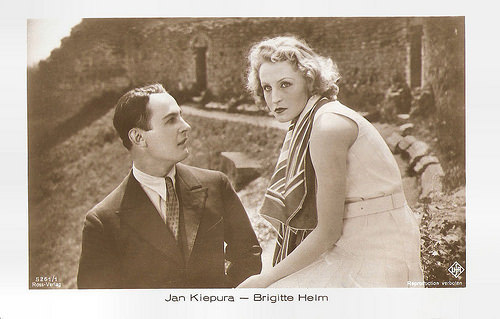
German postcard by Ross Verlag, no. 5261/1, 1930-1931. Photo: Ufa. Publicity still for Die singende Stadt/The Singing City (Carmine Gallone, 1930).

Postcard by Iris-Verlag. Photo: Lux Film / Cine-Allianz. Publicity still for Das Lied einer Nacht (Anatole Litvak, 1932).
The simple boy from Sosnowia
Jan Wiktor Kiepura was born as the son of a Polish baker and a Jewish mother in the mining town Sosnowia, Russia (now Poland). He started studying law in Warsaw, but at the same time he took singing lessons with Waclaw Brzesinsky and Tadeusz Leliwa.
He soon realized that singing was his real vocation and he gave his first concert in 1924. In 1925 he had his big debut as the lead singer of Gounod's Faust.
In the following months he gained popularity singing in Rigoletto by Verdi, Halka by Moniuszko, and Cavalleria Rusticana by Mascagni, at the Warsawian Wielki Theater.
He made an appearance on the Polish radio and the cinema also required him. He made his film debut in the silent Polish production O czym się nie myśli/Not In Your Thoughts (Edward Puchalski, 1926).
From then on, Kiepura was wanted everywhere in the world and he would perform even at La Scala in Milan and the Metropolitan in New York.
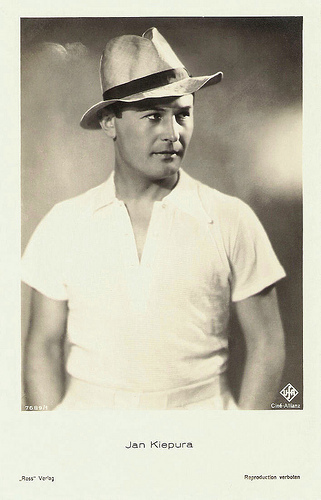
German postcard by Ross Verlag, Berlin, no. 7689/1, 1932-1933. Photo: Ciné Allianz / Ufa.
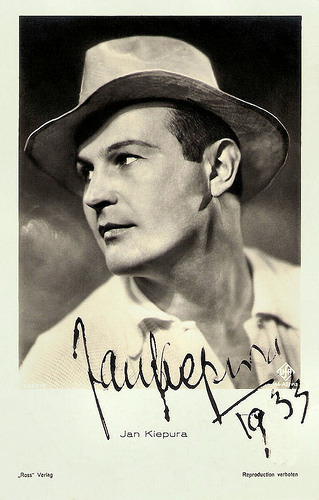
German postcard by Ross Verlag, Berlin, no. 7689/2, 1932-1933.
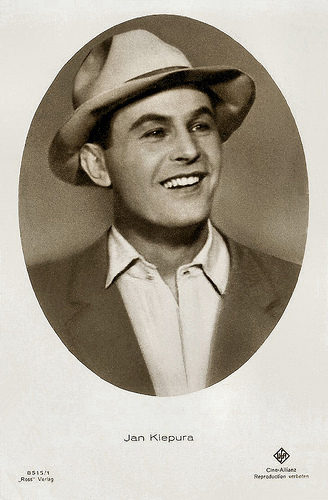
German Postcard by Ross Verlag, no. 8515/1, 1933-1934. Photo: Ufa / Cine-Alianz.
Dazzling Dream Couple
When the sound film arrived, Jan Kiepura was already a world famous opera star and with his beautiful tenor and his good looks he proved to be perfect for the German film operetta.
His first sound film was Die singende Stadt/City of Song (Carmine Gallone, 1930), shot at the Ufa studios at Neu Babelsberg. He played a naïve, good-natured singing sensation lured to fame and fortune by a big city vamp. She was played in the German version by Brigitte Helm and in the English language release by Betty Stockfield.
Kiepura himself lured a huge public into the cinemas with Das Lied einer Nacht/Tell Me Tonight (Anatole Litvak, 1932) and Ein Lied für Dich/A Song for You (Joe May, 1933).
On the set of Mein Herz ruft nach dir/My Heart Calls You (Carmine Gallone, 1934), he met the Hungarian lyrical soprano Marta Eggerth , who would become the woman of his life. The two often sang together in operettas, in concerts, on records, and in films.
The greatest success of this dazzling dream couple was Zauber der Bohème/Magic of the Bohemians (Géza von Bolváry, 1937).
Kiepura showed his acting skills in a double role in Ich liebe alle Frauen/I Love All Women (Carl Lamac, 1935) with Theo Lingen and Lien Deyers , and its French version J'aime toutes les femmes (Carl Lamac, 1935) with Danielle Darrieux and English version Give Us This Night (Alexander Hall, 1936).
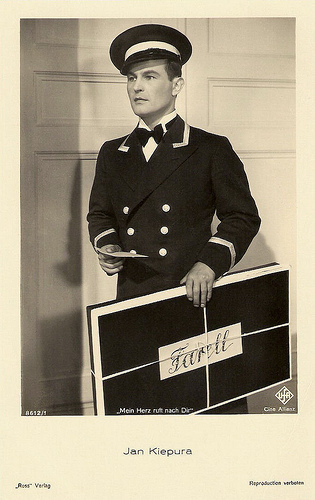
German postcard by Ross Verlag, no. 8612/1, 1933-1934. Photo: Ufa/Cine-Allianz. Still from Mein Herz Ruft nach Dir (Carmine Gallone, 1934).
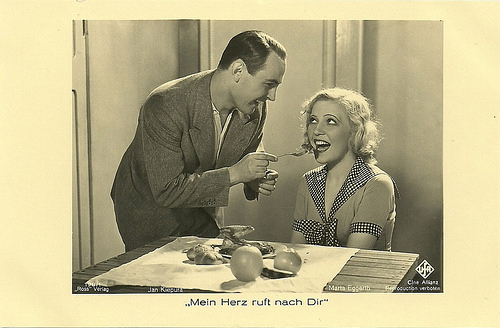
German postcard by Ross Verlag, no. 198/1. Photo: Cine Allianz / Ufa. Publicity still of Jan Kiepura and Martha Eggerth in the musical comedy Mein Herz ruft nach dir (Carmine Gallone, 1934).
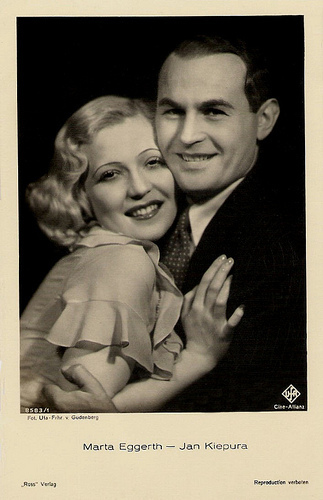
German postcard by Ross Verlag, no. 8583/1, 1933-1934. Photo: Ufa / Cine-Allianz / Frhr. von Gudenberg.
Sensation On Broadway
In March 1938 Jan Kiepura and Marta Eggerth (who was also partially Jewish) were forced to flee Europe due to the rise of Nazism. They took refuge in the South of France.
After World War II broke out, Kiepura was located in Paris. When France capitulated he went with Eggerth to New York. There he suppported organisations like Relief fund for Poland.
Kiepura en Eggerth caused a sensation on Broadway where they co-starred in The Merry Widow and La Polonaise.
After the war, they returned to Paris and starred in films like Addio Mimi!/Her Wonderful Lie (Carmine Gallone, 1947) - a modern adaptation of Giacomo Puccini's opera La Boheme, Valse brillante/Brilliant Waltz (Jean Boyer, 1949) and Das Land des Lächelns/Land of Smiles (Hans Deppe, Erik Ode, 1952).
In 1953, they settled down in the USA for good. Kiepura acquired American citizenship shortly afterwards. However, his career quickly declined.
At the age of 64, Jan Kiepura died of a heart attack in Harrison, in his New York State home, in 1966. He and Marta Eggerth had two sons.
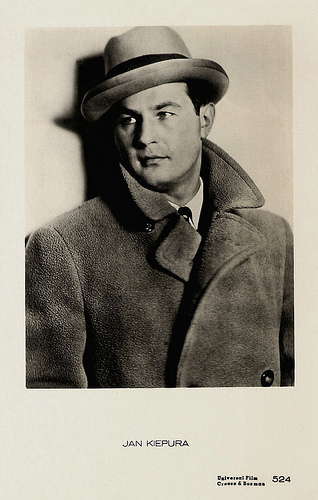
Dutch postcard by Croese & Bosman, no. 524. Photo: Universal Film.
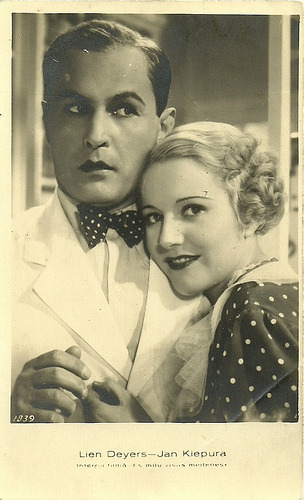
Latvian postcard by Ira, Riga, no. 1839. Photo: Jan Kiepura and Lien Deijers in Ich liebe alle Frauen (Carl Lamac, 1935).
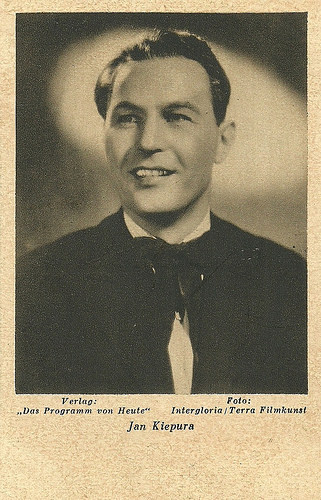
German postcard by Das Programm von Heute. Photo: Intergloria / Terra Filmkunst.
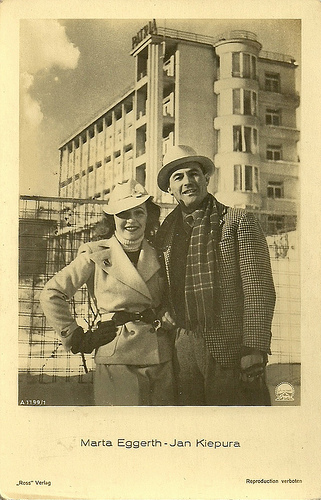
German postcard by Ross Verlag, no. A 1199/1. Photo: Paramount.
Martha Eggerth and Jan Kiepura in front of their hotel Patria in Krynica-Zdrój, a popular Polish ski resort, near the Czech border.
A royal scandal
This luxurious modernist Hotel Patria, commissioned by Kiepura, was designed by architect Bohdan Pniewski in 1927 and opened in 1933. It had cost Kiepura 3 million dollars, gathered by his successful musicals in Europe and the US.
Soon it became the toast of the town, attracting nobility and nouveaux-riches. It was run by Kiepura's parents, while Kiepura and Eggerth lived in Paris.
In January 1937 it was the site of a royal scandal when the just married Dutch crown princess Juliana and her husband Bernhard, Prince zur Lippe-Biesterfeld, had tried to deceive the press, by sending their luggage elsewhere, and hiding at the Hotel Patria. Soon their incognito as count and countess Von Sternberg [!] came out and the press sieged the hotel, while Kiepura and Eggerth came back over night from Paris to welcome the royal guests.
The weeks in Patria must have been big fun for the royal couple, filled with skiing in daytime and parties in the night time. Marta Eggerth later remembered how she had fun with the couple, changing the ski boots in front of the hotel rooms in the middle of the night.
During the war the hotel was used as a sanatorium for German officers. After the war the hotel was expropriated by the communists and became a state health resort.
When Kiepura visited Krynica in 1958 he was not allowed to stay there. After his death Marta Eggerth tried in vain to reclaim the building.
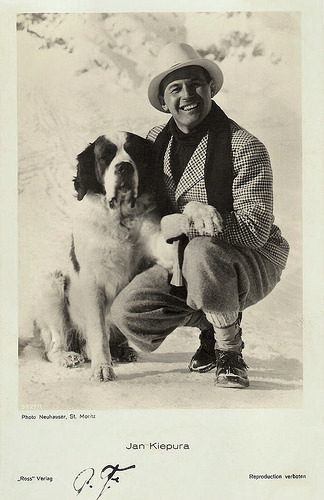
German postcard by Ross Verlag, no. 9327/1, 1935-1936. Photo: Neuhauser, St. Moritz.
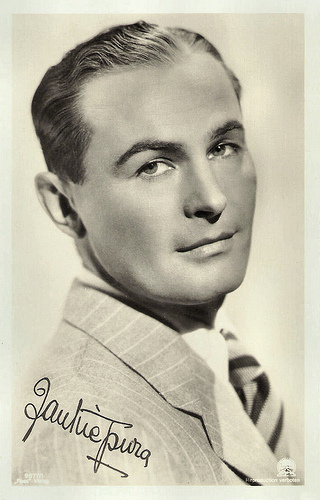
German postcard by Ross Verlag, no. 9877/1, 1935-1936. Photo: Paramount.
Jan Kiepura sings La Boheme. Source: Tenor65 (YouTube).
Jan Kiepura sings La donna e mobile. Source: Tenor65 (YouTube).
Sources: Hans-Michael Brock (The Concise Cinegraph), Thomas Staedeli (Cyranos), , Wikipedia, and .

Austrian postcard by Iris-Verlag, Wien, no. 720-1. Photo: Paul M. Vajda, Budapest.

German postcard by Ross Verlag, no. 5261/1, 1930-1931. Photo: Ufa. Publicity still for Die singende Stadt/The Singing City (Carmine Gallone, 1930).

Postcard by Iris-Verlag. Photo: Lux Film / Cine-Allianz. Publicity still for Das Lied einer Nacht (Anatole Litvak, 1932).
The simple boy from Sosnowia
Jan Wiktor Kiepura was born as the son of a Polish baker and a Jewish mother in the mining town Sosnowia, Russia (now Poland). He started studying law in Warsaw, but at the same time he took singing lessons with Waclaw Brzesinsky and Tadeusz Leliwa.
He soon realized that singing was his real vocation and he gave his first concert in 1924. In 1925 he had his big debut as the lead singer of Gounod's Faust.
In the following months he gained popularity singing in Rigoletto by Verdi, Halka by Moniuszko, and Cavalleria Rusticana by Mascagni, at the Warsawian Wielki Theater.
He made an appearance on the Polish radio and the cinema also required him. He made his film debut in the silent Polish production O czym się nie myśli/Not In Your Thoughts (Edward Puchalski, 1926).
From then on, Kiepura was wanted everywhere in the world and he would perform even at La Scala in Milan and the Metropolitan in New York.

German postcard by Ross Verlag, Berlin, no. 7689/1, 1932-1933. Photo: Ciné Allianz / Ufa.

German postcard by Ross Verlag, Berlin, no. 7689/2, 1932-1933.

German Postcard by Ross Verlag, no. 8515/1, 1933-1934. Photo: Ufa / Cine-Alianz.
Dazzling Dream Couple
When the sound film arrived, Jan Kiepura was already a world famous opera star and with his beautiful tenor and his good looks he proved to be perfect for the German film operetta.
His first sound film was Die singende Stadt/City of Song (Carmine Gallone, 1930), shot at the Ufa studios at Neu Babelsberg. He played a naïve, good-natured singing sensation lured to fame and fortune by a big city vamp. She was played in the German version by Brigitte Helm and in the English language release by Betty Stockfield.
Kiepura himself lured a huge public into the cinemas with Das Lied einer Nacht/Tell Me Tonight (Anatole Litvak, 1932) and Ein Lied für Dich/A Song for You (Joe May, 1933).
On the set of Mein Herz ruft nach dir/My Heart Calls You (Carmine Gallone, 1934), he met the Hungarian lyrical soprano Marta Eggerth , who would become the woman of his life. The two often sang together in operettas, in concerts, on records, and in films.
The greatest success of this dazzling dream couple was Zauber der Bohème/Magic of the Bohemians (Géza von Bolváry, 1937).
Kiepura showed his acting skills in a double role in Ich liebe alle Frauen/I Love All Women (Carl Lamac, 1935) with Theo Lingen and Lien Deyers , and its French version J'aime toutes les femmes (Carl Lamac, 1935) with Danielle Darrieux and English version Give Us This Night (Alexander Hall, 1936).

German postcard by Ross Verlag, no. 8612/1, 1933-1934. Photo: Ufa/Cine-Allianz. Still from Mein Herz Ruft nach Dir (Carmine Gallone, 1934).

German postcard by Ross Verlag, no. 198/1. Photo: Cine Allianz / Ufa. Publicity still of Jan Kiepura and Martha Eggerth in the musical comedy Mein Herz ruft nach dir (Carmine Gallone, 1934).

German postcard by Ross Verlag, no. 8583/1, 1933-1934. Photo: Ufa / Cine-Allianz / Frhr. von Gudenberg.
Sensation On Broadway
In March 1938 Jan Kiepura and Marta Eggerth (who was also partially Jewish) were forced to flee Europe due to the rise of Nazism. They took refuge in the South of France.
After World War II broke out, Kiepura was located in Paris. When France capitulated he went with Eggerth to New York. There he suppported organisations like Relief fund for Poland.
Kiepura en Eggerth caused a sensation on Broadway where they co-starred in The Merry Widow and La Polonaise.
After the war, they returned to Paris and starred in films like Addio Mimi!/Her Wonderful Lie (Carmine Gallone, 1947) - a modern adaptation of Giacomo Puccini's opera La Boheme, Valse brillante/Brilliant Waltz (Jean Boyer, 1949) and Das Land des Lächelns/Land of Smiles (Hans Deppe, Erik Ode, 1952).
In 1953, they settled down in the USA for good. Kiepura acquired American citizenship shortly afterwards. However, his career quickly declined.
At the age of 64, Jan Kiepura died of a heart attack in Harrison, in his New York State home, in 1966. He and Marta Eggerth had two sons.

Dutch postcard by Croese & Bosman, no. 524. Photo: Universal Film.

Latvian postcard by Ira, Riga, no. 1839. Photo: Jan Kiepura and Lien Deijers in Ich liebe alle Frauen (Carl Lamac, 1935).

German postcard by Das Programm von Heute. Photo: Intergloria / Terra Filmkunst.

German postcard by Ross Verlag, no. A 1199/1. Photo: Paramount.
Martha Eggerth and Jan Kiepura in front of their hotel Patria in Krynica-Zdrój, a popular Polish ski resort, near the Czech border.
A royal scandal
This luxurious modernist Hotel Patria, commissioned by Kiepura, was designed by architect Bohdan Pniewski in 1927 and opened in 1933. It had cost Kiepura 3 million dollars, gathered by his successful musicals in Europe and the US.
Soon it became the toast of the town, attracting nobility and nouveaux-riches. It was run by Kiepura's parents, while Kiepura and Eggerth lived in Paris.
In January 1937 it was the site of a royal scandal when the just married Dutch crown princess Juliana and her husband Bernhard, Prince zur Lippe-Biesterfeld, had tried to deceive the press, by sending their luggage elsewhere, and hiding at the Hotel Patria. Soon their incognito as count and countess Von Sternberg [!] came out and the press sieged the hotel, while Kiepura and Eggerth came back over night from Paris to welcome the royal guests.
The weeks in Patria must have been big fun for the royal couple, filled with skiing in daytime and parties in the night time. Marta Eggerth later remembered how she had fun with the couple, changing the ski boots in front of the hotel rooms in the middle of the night.
During the war the hotel was used as a sanatorium for German officers. After the war the hotel was expropriated by the communists and became a state health resort.
When Kiepura visited Krynica in 1958 he was not allowed to stay there. After his death Marta Eggerth tried in vain to reclaim the building.

German postcard by Ross Verlag, no. 9327/1, 1935-1936. Photo: Neuhauser, St. Moritz.

German postcard by Ross Verlag, no. 9877/1, 1935-1936. Photo: Paramount.
Jan Kiepura sings La Boheme. Source: Tenor65 (YouTube).
Jan Kiepura sings La donna e mobile. Source: Tenor65 (YouTube).
Sources: Hans-Michael Brock (The Concise Cinegraph), Thomas Staedeli (Cyranos), , Wikipedia, and .
Published on October 15, 2014 23:00
Marie Dubois (1937-2014)
Blonde French actress Marie Dubois died today near Pau in the South of France. She appeared in several classics of the Nouvelle Vague, like Tirez sur le pianist (François Truffaut, 1960), Une femme est une femme (Jean-Luc Godard, 1961), and Jules et Jim (François Truffaut, 1962). She has worked as supporting and sometimes leading actress on stage, screen, and television. In the 1970s, she acted for a new generation of avant-garde directors, including Claude Sautet. Marie Dubois suffered from multiple sclerosis for many years and had campaigned to raise public awareness about the disease and support for research. She was 77.
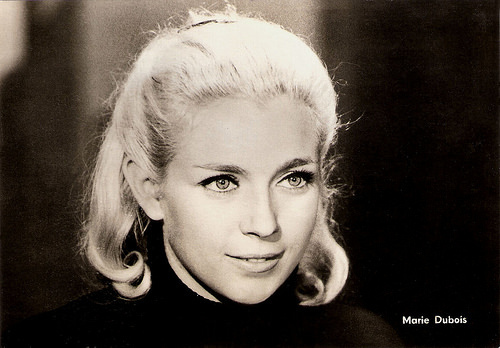
East-German postcard by VEB Progress Filmvertrieb, no. 186/69.
New Wave
Marie Dubois was born Claudine Lucie Pauline Huzé in 1937 in Paris. She studied at l'École de la rue Blanche (ENSATT) and followed lessons by Henri Rollan at the Conservatoire.
She made her film debut in 1959, but first gained notice the next year as waitress Léna in the crime drama Tirez sur le pianist/Shoot the Piano Player (François Truffaut, 1960).
In this loving homage to Hollywood gangster films, Charles Aznavour starred as the piano player with whom Dubois’ character is in love. Truffaut first noticed Marie Dubois when he came across her headshot during pre-production and attempted to set up several meetings with the actress, but Dubois never showed up. Truffaut finally saw Dubois perform on a TV show and immediately wanted to cast her shortly before filming began. Truffaut changed her name Claudine Huzé to Marie Dubois because she reminded him of the titular character of his friend Jacques Audiberti's novel Marie Dubois.
She has since played mainly supporting roles. In the 1960s she appeared in the Nouvelle Vague (New Wave) films Une femme est une femme/A Woman Is a Woman (Jean-Luc Godard, 1961) with Anna Karina , Jules et Jim/Jules and Jim (François Truffaut, 1962) with Jeanne Moreau , and Le Voleur/The Thief of Paris (Louis Malle, 1964) with Jean-Paul Belmondo .
With Belmondo she co-starred in four films. She also played in comedies like La Ronde/Circle of Love (Roger Vadim, 1964), La Grande Vadrouille (Gérard Oury, 1966), and Monte Carlo or Bust/Those Daring Young Men in Their Jaunty Jalopies (Ken Annakin, 1969).
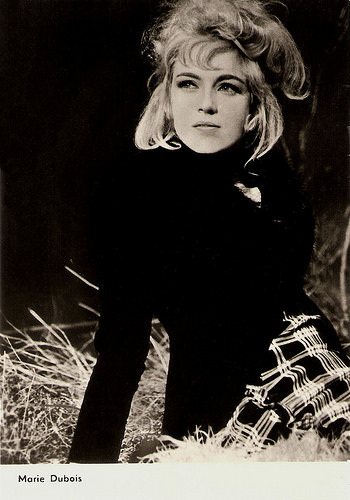
East-German postcard by VEB Progress Filmvertrieb, no. 2918, 1967. Photo: publicity still for L'âge ingrate/That Tender Age (Gilles Grangier, 1964).
One the faces of the French avant-garde
Marie Dubois liked to work with young directors and she became one the faces of the French avant-garde cinema of the 1970s. These films include La Maison des Bories/The House of the Bories (Jacques Doniol-Valcroze, 1970) with Matthieu Carriere, Bof ... Anatomie d'un Livreur/Bof (Claude Faraldo, 1971) and the black-and-white Swiss feature Les Arpenteurs/The Surveyors (Michel Soutter, 1972).
More mainstream was the spy thriller Le Serpent/Night Flight from Moscow (Henri Verneuil, 1973) with Yul Brynner and Dirk Bogarde . An artistic and commercial success was Vincent, François, Paul et les autres/Vincent, Francois, Paul and the Others (Claude Sautet, 1974), a gentle character study of a group of friends ( Gérard Dépardieu , Yves Montand , Serge Reggiani and Michel Piccoli ) who meet each weekend in the country for food, drink and conversation.
Another highlight was Luchino Visconti’s last film, the period drama L'Innocente/The Innocent (1976). In 1978 she won the César Award for Best Supporting Actress for her role as Dominique Montlaur in the psychological thriller La Menace (Alain Corneau, 1977) starring Yves Montand.
Another success was the satire Mon Oncle d'Amérique/My American Uncle (Alain Resnais, 1980) which scored a hit with filmgoers and critics alike, and was honoured with six Cesar Awards.
In the 1980s she also appeared in the seriocomedy Garçon!/Boy! (Claude Sautet, 1983) with Yves Montand as a middle-aged waiter, and La Petite Sirene (Roger Andrieux, 1984).
For her role as Lucette Beulemans in Descente aux enfers/Descent Into Hell (Francis Girod, 1986), she received a second César nomination for Best Supporting Actress. Marie Dubois’s last screen role was as the grandmother in the TV film Le bon fils/The Good Son (Irène Jouannet, 2001).
She married French film actor Serge Rousseau in 1961 and they remained together until his death in 2007.
Part of Marie Dubois' screen test for Tirez sur le pianist. Source: Luke the Lux (YouTube).
Sources: Le Monde (French), Allocine (French), AllMovie, Wikipedia and .

East-German postcard by VEB Progress Filmvertrieb, no. 186/69.
New Wave
Marie Dubois was born Claudine Lucie Pauline Huzé in 1937 in Paris. She studied at l'École de la rue Blanche (ENSATT) and followed lessons by Henri Rollan at the Conservatoire.
She made her film debut in 1959, but first gained notice the next year as waitress Léna in the crime drama Tirez sur le pianist/Shoot the Piano Player (François Truffaut, 1960).
In this loving homage to Hollywood gangster films, Charles Aznavour starred as the piano player with whom Dubois’ character is in love. Truffaut first noticed Marie Dubois when he came across her headshot during pre-production and attempted to set up several meetings with the actress, but Dubois never showed up. Truffaut finally saw Dubois perform on a TV show and immediately wanted to cast her shortly before filming began. Truffaut changed her name Claudine Huzé to Marie Dubois because she reminded him of the titular character of his friend Jacques Audiberti's novel Marie Dubois.
She has since played mainly supporting roles. In the 1960s she appeared in the Nouvelle Vague (New Wave) films Une femme est une femme/A Woman Is a Woman (Jean-Luc Godard, 1961) with Anna Karina , Jules et Jim/Jules and Jim (François Truffaut, 1962) with Jeanne Moreau , and Le Voleur/The Thief of Paris (Louis Malle, 1964) with Jean-Paul Belmondo .
With Belmondo she co-starred in four films. She also played in comedies like La Ronde/Circle of Love (Roger Vadim, 1964), La Grande Vadrouille (Gérard Oury, 1966), and Monte Carlo or Bust/Those Daring Young Men in Their Jaunty Jalopies (Ken Annakin, 1969).

East-German postcard by VEB Progress Filmvertrieb, no. 2918, 1967. Photo: publicity still for L'âge ingrate/That Tender Age (Gilles Grangier, 1964).
One the faces of the French avant-garde
Marie Dubois liked to work with young directors and she became one the faces of the French avant-garde cinema of the 1970s. These films include La Maison des Bories/The House of the Bories (Jacques Doniol-Valcroze, 1970) with Matthieu Carriere, Bof ... Anatomie d'un Livreur/Bof (Claude Faraldo, 1971) and the black-and-white Swiss feature Les Arpenteurs/The Surveyors (Michel Soutter, 1972).
More mainstream was the spy thriller Le Serpent/Night Flight from Moscow (Henri Verneuil, 1973) with Yul Brynner and Dirk Bogarde . An artistic and commercial success was Vincent, François, Paul et les autres/Vincent, Francois, Paul and the Others (Claude Sautet, 1974), a gentle character study of a group of friends ( Gérard Dépardieu , Yves Montand , Serge Reggiani and Michel Piccoli ) who meet each weekend in the country for food, drink and conversation.
Another highlight was Luchino Visconti’s last film, the period drama L'Innocente/The Innocent (1976). In 1978 she won the César Award for Best Supporting Actress for her role as Dominique Montlaur in the psychological thriller La Menace (Alain Corneau, 1977) starring Yves Montand.
Another success was the satire Mon Oncle d'Amérique/My American Uncle (Alain Resnais, 1980) which scored a hit with filmgoers and critics alike, and was honoured with six Cesar Awards.
In the 1980s she also appeared in the seriocomedy Garçon!/Boy! (Claude Sautet, 1983) with Yves Montand as a middle-aged waiter, and La Petite Sirene (Roger Andrieux, 1984).
For her role as Lucette Beulemans in Descente aux enfers/Descent Into Hell (Francis Girod, 1986), she received a second César nomination for Best Supporting Actress. Marie Dubois’s last screen role was as the grandmother in the TV film Le bon fils/The Good Son (Irène Jouannet, 2001).
She married French film actor Serge Rousseau in 1961 and they remained together until his death in 2007.
Part of Marie Dubois' screen test for Tirez sur le pianist. Source: Luke the Lux (YouTube).
Sources: Le Monde (French), Allocine (French), AllMovie, Wikipedia and .
Published on October 15, 2014 14:54
October 14, 2014
Jean Sorel
With his dreamy features and glossy, immovable hair, Jean Sorel (1934) was one of the most handsome leading men of the European cinema in the 1960s and 1970s. He worked in the French, Italian and later in the Spanish cinema with such directors as Luis Buñuel and Luchino Visconti. Since 1980 he appeared mostly on television.
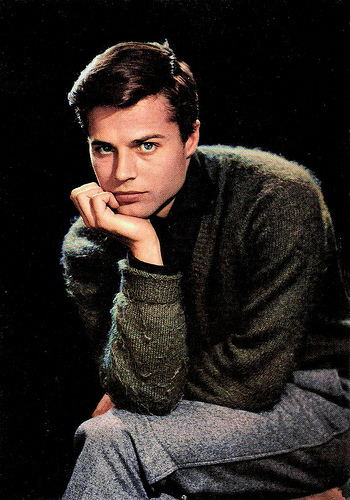
French postcard by Editions P.I., Paris, no. 1049. Photo: Studio Vallois.
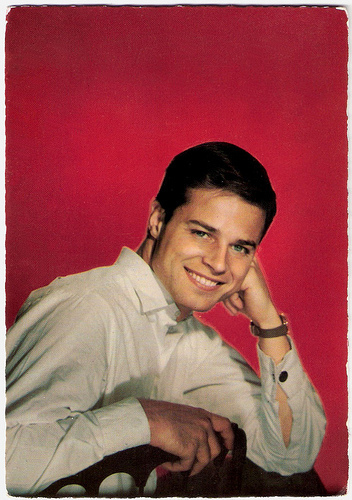
French postcard by E.D.U.G., no. 173. Photo: Sam Lévin.
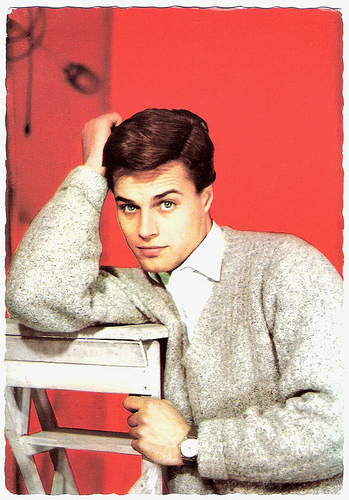
French postcard by E.D.U.G., no. 143. Photo: Lucienne Chevert.
Womanizer with Good Looks
Jean Sorel was born as Jean de Combault-Roquebrune in Marseille, France, in 1934. Sorel is from a noble family of officers.
His father, Guy de Combaud Roquebrune was a founder of the French journal Liberté. He died in battle against the Nazis in September 1944 as commander of a French paratrooper unit of the British Special Air Force.
Sorel began his studies at the Ecole Normale Supérieure to pursue a diplomatic career, but he abandoned his studies when he fell in love with the theatre. He made his stage debut during his period in a production of William Shakespeare's The Merchant of Venice.
In 1956 and 1957 he had to fight in the Algerian war. After his military service he chose for an acting career and made his film debut with a small part in J'irai cracher sur vos tombes/I’ll Spit On Your Grave (Michel Gast, 1959) starring Christian Marquand.
His breakthrough was a major role in the now forgotten film Les Lionceaux/Bitter Fruit of Love (Jacques Bourdon, 1960) in which he played a womanizer with good looks.
In the following years he became established with supporting parts in productions like Vive Henri IV...vive l'amour!/Long Live Henry IV... Long Live Love (Claude Autant-Lara, 1961), L'oro di Roma/Gold of Rome (Carlo Lizzani, 1961), Julia, Du bist zauberhaft/Adorable Julia (Alfred Weidenmann, 1962), Germinal (Yves Allégret, 1963), and La ronde/The Circle of Love (Roger Vadim, 1964) with Jane Fonda.
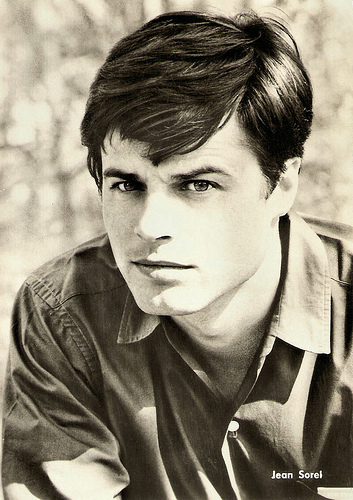
East-German postcard by VEB Progress, Berlin, no. 28/70, 1970. Retail price: 0,20 DM. Photo: Unifrance-Film.
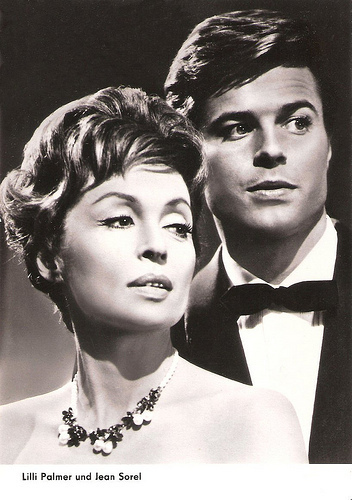
East-German postcard by VEB Progress, Berlin, no. 1897, 1964. Retail price: 0,20 DM. Photo: Progress. Publicity still for Julia, Du bist zauberhaft/Adorable Julia (Alfred Weidenmann, 1962) with Lilli Palmer .
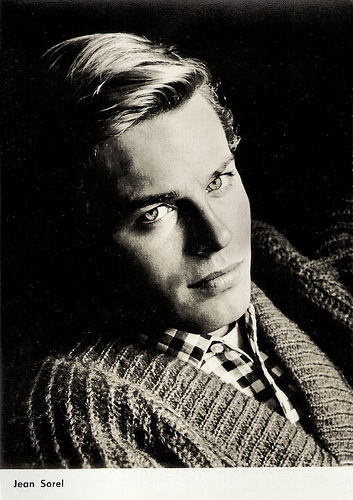
East-German postcard by VEB Progress, Berlin, no. 2.573.
Brilliant Career
In the next decade Jean Sorel had a brilliant career. Especially his work in Italian films established him as one of the most popular actors at an international level. He worked with such directors as Alberto Lattuada, Dino Risi, Franco Brusati, Nanni Loy, Damiano Damiani, and Mauro Bolognini.
Luchino Visconti directed him in the masterpiece Vaghe stelle dell'Orsa/Sandra (Luchino Visconti, 1965) as the incestuous brother of Claudia Cardinale . The film won both the Silver Ribbon and the Golden Lion at the festival of Venice.
Two years later, he starred in another masterpiece, Belle de jour/Beauty of the Day (Luis Buñuel, 1967). Sorel played the paralyzed husband of beautiful Catherine Deneuve , in her most famous interpretation.
He also appeared in productions like Sidney Lumet's fiery Vu du pont/A View From the Bridge (Sidney Lumet, 1962) based on the play by Arthur Miller, and the British-French thriller The Day of the Jackal (Fred Zinnemann, 1973).
Apart from these classics, Sorel appeared often in genre films such as Paranoia/A Quiet Place to Kill (Umberto Lenzi, 1970). In this cult thriller set in Majorca, he fights back after his ex-wife Carroll Baker tries to murder him for a second time.
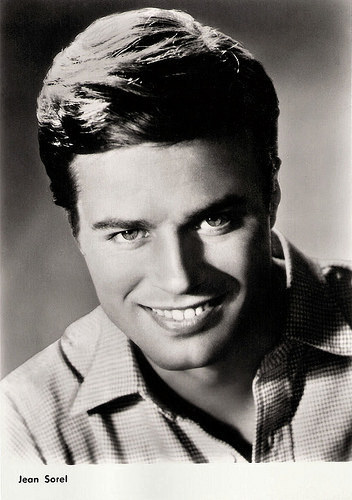
East-German postcard by VEB Progress, Berlin, no. 2.210, 1965. Retail price: 0,20 DM. Photo: Progress.
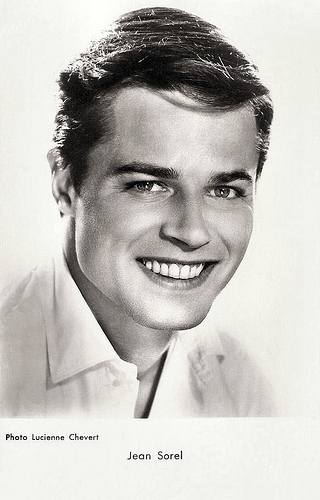
French postcard by Editions P.I., Paris, no. 1107. Photo: Lucienne Chevert.
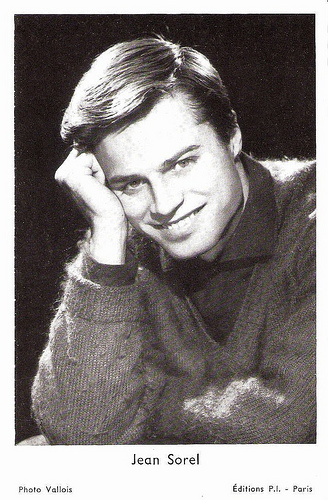
French collectors card by Editions P.I., Paris. Photo: Vallois.
Reunited With Claudia Cardinale
From the mid-1970s, Jean Sorel reduced his film activities and he appeared mostly on television and in the theatre (often under the direction of Roger Planchon).
To his well-known films of those years belong Les enfants du placard/Closet Children (Benoît Jacquot, 1977) with Brigitte Fossey, Der Mann im Schilf/The Man in the Rushes (Manfred Purzer, 1978), Les soeurs Bronte/The Bronte Sisters (André Téchiné, 1979) with Isabelle Adjani and Isabelle Huppert , the TV film La naissance du jour/The Birth of the Day (Jacques Demy, 1980) with Danièle Delorme and Dominique Sanda , and Aspern/The Aspern Papers (Eduardo de Gregorio, 1985) with Bulle Ogier and Alida Valli .
After that he slowly retired from the film business. There followed only sporadic appearances in front of the camera like the Bud Spencer vehicle Un piede in paradise/Speaking of the Devil (Enzo Barboni, 1991), and the TV mini-series Deserto di fuoco/The Desert of Fire (Enzo G. Castellari, 1997) in which he was reunited with Claudia Cardinale .
Recent films are L'ultimo Pulcinella/The Last Pulcinella (Maurizio Scaparro, 2008) with Massimo Ranieri and Adriana Asti, and the short drama Il teatro dei ricordi/The Theatre of Memories (Angela Bevilacqua, Giorgia Randolfi, Francesca Saracino, 2014).
Since 1963, Jean Sorel is married to Italian actress Anna-Maria Ferrero , who gave up her acting career soon after their marriage. Today they live in Paris and Rome.
Scene from Vaghe stelle dell'Orsa/Sandra (Luchino Visconti, 1965) with Claudia Cardinale and Michael Craig. Source: Classic Movies Store.
Trailer of Belle de Jour (1967). Source: BestForeignMovies (YouTube).
Love scene in La volpe dalla coda di velluto/In the Eye of the Hurricane (1971) between Analía Gadé and Jean Sorel. Source: apkie (YouTube).
Sources: Thomas Staedeli (Cyranos), Michael Musto (The Village Voice), Wikipedia and .

French postcard by Editions P.I., Paris, no. 1049. Photo: Studio Vallois.

French postcard by E.D.U.G., no. 173. Photo: Sam Lévin.

French postcard by E.D.U.G., no. 143. Photo: Lucienne Chevert.
Womanizer with Good Looks
Jean Sorel was born as Jean de Combault-Roquebrune in Marseille, France, in 1934. Sorel is from a noble family of officers.
His father, Guy de Combaud Roquebrune was a founder of the French journal Liberté. He died in battle against the Nazis in September 1944 as commander of a French paratrooper unit of the British Special Air Force.
Sorel began his studies at the Ecole Normale Supérieure to pursue a diplomatic career, but he abandoned his studies when he fell in love with the theatre. He made his stage debut during his period in a production of William Shakespeare's The Merchant of Venice.
In 1956 and 1957 he had to fight in the Algerian war. After his military service he chose for an acting career and made his film debut with a small part in J'irai cracher sur vos tombes/I’ll Spit On Your Grave (Michel Gast, 1959) starring Christian Marquand.
His breakthrough was a major role in the now forgotten film Les Lionceaux/Bitter Fruit of Love (Jacques Bourdon, 1960) in which he played a womanizer with good looks.
In the following years he became established with supporting parts in productions like Vive Henri IV...vive l'amour!/Long Live Henry IV... Long Live Love (Claude Autant-Lara, 1961), L'oro di Roma/Gold of Rome (Carlo Lizzani, 1961), Julia, Du bist zauberhaft/Adorable Julia (Alfred Weidenmann, 1962), Germinal (Yves Allégret, 1963), and La ronde/The Circle of Love (Roger Vadim, 1964) with Jane Fonda.

East-German postcard by VEB Progress, Berlin, no. 28/70, 1970. Retail price: 0,20 DM. Photo: Unifrance-Film.

East-German postcard by VEB Progress, Berlin, no. 1897, 1964. Retail price: 0,20 DM. Photo: Progress. Publicity still for Julia, Du bist zauberhaft/Adorable Julia (Alfred Weidenmann, 1962) with Lilli Palmer .

East-German postcard by VEB Progress, Berlin, no. 2.573.
Brilliant Career
In the next decade Jean Sorel had a brilliant career. Especially his work in Italian films established him as one of the most popular actors at an international level. He worked with such directors as Alberto Lattuada, Dino Risi, Franco Brusati, Nanni Loy, Damiano Damiani, and Mauro Bolognini.
Luchino Visconti directed him in the masterpiece Vaghe stelle dell'Orsa/Sandra (Luchino Visconti, 1965) as the incestuous brother of Claudia Cardinale . The film won both the Silver Ribbon and the Golden Lion at the festival of Venice.
Two years later, he starred in another masterpiece, Belle de jour/Beauty of the Day (Luis Buñuel, 1967). Sorel played the paralyzed husband of beautiful Catherine Deneuve , in her most famous interpretation.
He also appeared in productions like Sidney Lumet's fiery Vu du pont/A View From the Bridge (Sidney Lumet, 1962) based on the play by Arthur Miller, and the British-French thriller The Day of the Jackal (Fred Zinnemann, 1973).
Apart from these classics, Sorel appeared often in genre films such as Paranoia/A Quiet Place to Kill (Umberto Lenzi, 1970). In this cult thriller set in Majorca, he fights back after his ex-wife Carroll Baker tries to murder him for a second time.

East-German postcard by VEB Progress, Berlin, no. 2.210, 1965. Retail price: 0,20 DM. Photo: Progress.

French postcard by Editions P.I., Paris, no. 1107. Photo: Lucienne Chevert.

French collectors card by Editions P.I., Paris. Photo: Vallois.
Reunited With Claudia Cardinale
From the mid-1970s, Jean Sorel reduced his film activities and he appeared mostly on television and in the theatre (often under the direction of Roger Planchon).
To his well-known films of those years belong Les enfants du placard/Closet Children (Benoît Jacquot, 1977) with Brigitte Fossey, Der Mann im Schilf/The Man in the Rushes (Manfred Purzer, 1978), Les soeurs Bronte/The Bronte Sisters (André Téchiné, 1979) with Isabelle Adjani and Isabelle Huppert , the TV film La naissance du jour/The Birth of the Day (Jacques Demy, 1980) with Danièle Delorme and Dominique Sanda , and Aspern/The Aspern Papers (Eduardo de Gregorio, 1985) with Bulle Ogier and Alida Valli .
After that he slowly retired from the film business. There followed only sporadic appearances in front of the camera like the Bud Spencer vehicle Un piede in paradise/Speaking of the Devil (Enzo Barboni, 1991), and the TV mini-series Deserto di fuoco/The Desert of Fire (Enzo G. Castellari, 1997) in which he was reunited with Claudia Cardinale .
Recent films are L'ultimo Pulcinella/The Last Pulcinella (Maurizio Scaparro, 2008) with Massimo Ranieri and Adriana Asti, and the short drama Il teatro dei ricordi/The Theatre of Memories (Angela Bevilacqua, Giorgia Randolfi, Francesca Saracino, 2014).
Since 1963, Jean Sorel is married to Italian actress Anna-Maria Ferrero , who gave up her acting career soon after their marriage. Today they live in Paris and Rome.
Scene from Vaghe stelle dell'Orsa/Sandra (Luchino Visconti, 1965) with Claudia Cardinale and Michael Craig. Source: Classic Movies Store.
Trailer of Belle de Jour (1967). Source: BestForeignMovies (YouTube).
Love scene in La volpe dalla coda di velluto/In the Eye of the Hurricane (1971) between Analía Gadé and Jean Sorel. Source: apkie (YouTube).
Sources: Thomas Staedeli (Cyranos), Michael Musto (The Village Voice), Wikipedia and .
Published on October 14, 2014 23:00
October 13, 2014
Alice Field
French actress Alice Field (1903-1969) started out in the silent film era. Her career got on steam in the 1930s, when she starred in several French language versions of German film classics.
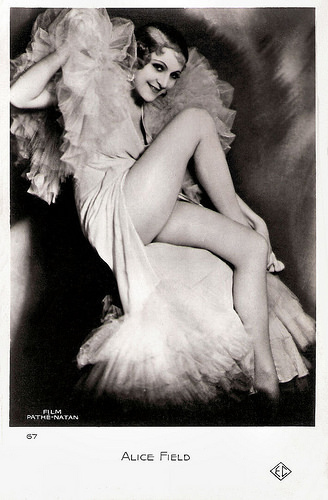
French postcard by EC, no. 67. Photo: Film Pathé-Nathan.
Atlantis
Alice Field was born as Alice Fille in Alger, Algeria in 1903.
She made her film debut opposite Saint-Granier in the silent production Villa Destin (Marcel L’Herbier, 1921), based on a play by Oscar Wilde. That same year she played the second wife of a well-to-do Algerian ( Marcel Vibert ) in Visages voilés... âmes closes/The Sheik's Wife (Henry Roussel, 1921).
She then focused in stage work, but returned to the cinema when sound film was introduced. She played the wife of Constant Rémy in Atlantis (Ewald André Dupont, Jean Kemm, 1930), a heavily fictionalized version of the RMS Titanic story. It was filmed simultaneously with the English-language version Atlantic (1929), the-German language version Atlantik (1929) and the silent version Atlantic (1929).
Her film career got on steam. The following years Field appeared in several films including La maison de La Flèche/The house of La Flèche (Henri Fescourt, 1930) with Annabella , Le refuge/The Refuge (Léon Mathot, 1931) and Vous serez ma femme/You Will Be My Wife (Carl Boese, Serge de Poligny, 1932) with Roger Tréville . The latter was the alternative language version of the Ufa comedy Der Frechdachs/The Cheeky Devil (Carl Boese, Heinz Hille, 1932) with Willy Fritsch and Camilla Horn .
Throughout the 1930s, Field played leading and supporting roles in a dozen French films. Most of them were run-of–the-mill, but quite watchable are Cette vieille canaille/The Old Rogue (Anatole Litvak, 1933) featuring Harry Baur , and the crime drama Police mondaine/Worldly Police (Michel Bernheim, Christian Chamborant, 1937), in which she starred opposite Charles Vanel and Pierre Larquey.
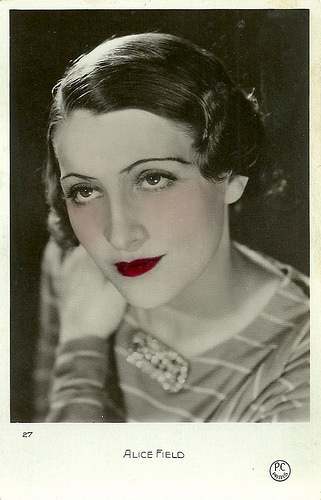
French postcard by P.C., Paris, no. 27.
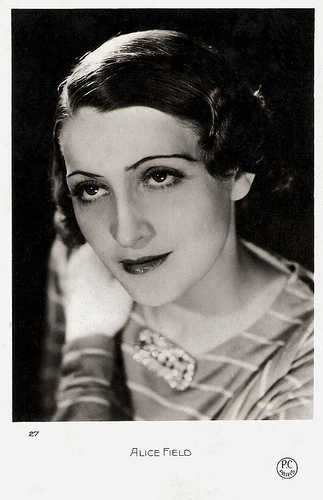
French postcard by P.C., Paris, no. 27.
Playtime
Alice Field starred in the spectacle Le tigre du Bengale/The Tiger of Eschnapur (Richard Eichberg, 1938) and the sequel Le tombeau hindou/The Indian Tomb (Richard Eichberg, 1938). These were the French language versions of the German two-parter Das indische Grabmal (Richard Eichberg, 1938) and Der Tiger von Eschnapur (Richard Eichberg, 1938).
These films were remakes of Joe May's 1919 silent films of the same name. Both versions were based on a novel by Thea Von Harbou, at one time the wife of director Fritz Lang. In turn, both Der Tiger von Eschnapur and Das Indische Grabmal were remade in 1959 by Fritz Lang.
During the 1940s, Field continued to star in French films. Among her films were Campement 13/Camp 13 (Jacques Constant, 1940), and the comedy La loi du printemps/The law of spring (Jacques Daniel-Norman, 1942) with Pierre Renoir .
After the war, she kept busy although her parts became smaller. Among her films of the 1950s and 1960s are the comedy drama Au p'tit zouave/The little Zouave (Gilles Grangier, 1950) starring François Périer , the Euro-spy film Pleins feux sur Stanislas/Killer Spy (Jean-Charles Dudrumet, 1965) starring Jean Marais , and the romance Un garçon, une fille. Le dix-septième ciel/A boy, a girl. The seventeenth sky (Serge Korber, 1966) with Jean Louis Trintignant and Marie Dubois.
She continued to play roles on stage and also on television, like in the series Au théâtre ce soir/On stage tonight (1966-1970). Her final film appearance was a small part in the classic comedy Playtime (Jacques Tati, 1967) with Jacques Tati as Monsieur Hulot.
Alice Field died in 1969 in Paris. She was 66.
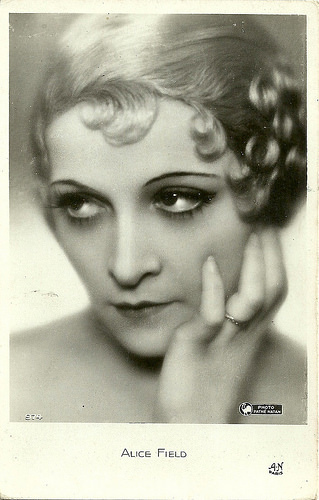
French postcard by A.N., Paris, no. 974. Photo: Pathé Natan.
Sources: AllMovie, Wikipedia (French) and .

French postcard by EC, no. 67. Photo: Film Pathé-Nathan.
Atlantis
Alice Field was born as Alice Fille in Alger, Algeria in 1903.
She made her film debut opposite Saint-Granier in the silent production Villa Destin (Marcel L’Herbier, 1921), based on a play by Oscar Wilde. That same year she played the second wife of a well-to-do Algerian ( Marcel Vibert ) in Visages voilés... âmes closes/The Sheik's Wife (Henry Roussel, 1921).
She then focused in stage work, but returned to the cinema when sound film was introduced. She played the wife of Constant Rémy in Atlantis (Ewald André Dupont, Jean Kemm, 1930), a heavily fictionalized version of the RMS Titanic story. It was filmed simultaneously with the English-language version Atlantic (1929), the-German language version Atlantik (1929) and the silent version Atlantic (1929).
Her film career got on steam. The following years Field appeared in several films including La maison de La Flèche/The house of La Flèche (Henri Fescourt, 1930) with Annabella , Le refuge/The Refuge (Léon Mathot, 1931) and Vous serez ma femme/You Will Be My Wife (Carl Boese, Serge de Poligny, 1932) with Roger Tréville . The latter was the alternative language version of the Ufa comedy Der Frechdachs/The Cheeky Devil (Carl Boese, Heinz Hille, 1932) with Willy Fritsch and Camilla Horn .
Throughout the 1930s, Field played leading and supporting roles in a dozen French films. Most of them were run-of–the-mill, but quite watchable are Cette vieille canaille/The Old Rogue (Anatole Litvak, 1933) featuring Harry Baur , and the crime drama Police mondaine/Worldly Police (Michel Bernheim, Christian Chamborant, 1937), in which she starred opposite Charles Vanel and Pierre Larquey.

French postcard by P.C., Paris, no. 27.

French postcard by P.C., Paris, no. 27.
Playtime
Alice Field starred in the spectacle Le tigre du Bengale/The Tiger of Eschnapur (Richard Eichberg, 1938) and the sequel Le tombeau hindou/The Indian Tomb (Richard Eichberg, 1938). These were the French language versions of the German two-parter Das indische Grabmal (Richard Eichberg, 1938) and Der Tiger von Eschnapur (Richard Eichberg, 1938).
These films were remakes of Joe May's 1919 silent films of the same name. Both versions were based on a novel by Thea Von Harbou, at one time the wife of director Fritz Lang. In turn, both Der Tiger von Eschnapur and Das Indische Grabmal were remade in 1959 by Fritz Lang.
During the 1940s, Field continued to star in French films. Among her films were Campement 13/Camp 13 (Jacques Constant, 1940), and the comedy La loi du printemps/The law of spring (Jacques Daniel-Norman, 1942) with Pierre Renoir .
After the war, she kept busy although her parts became smaller. Among her films of the 1950s and 1960s are the comedy drama Au p'tit zouave/The little Zouave (Gilles Grangier, 1950) starring François Périer , the Euro-spy film Pleins feux sur Stanislas/Killer Spy (Jean-Charles Dudrumet, 1965) starring Jean Marais , and the romance Un garçon, une fille. Le dix-septième ciel/A boy, a girl. The seventeenth sky (Serge Korber, 1966) with Jean Louis Trintignant and Marie Dubois.
She continued to play roles on stage and also on television, like in the series Au théâtre ce soir/On stage tonight (1966-1970). Her final film appearance was a small part in the classic comedy Playtime (Jacques Tati, 1967) with Jacques Tati as Monsieur Hulot.
Alice Field died in 1969 in Paris. She was 66.

French postcard by A.N., Paris, no. 974. Photo: Pathé Natan.
Sources: AllMovie, Wikipedia (French) and .
Published on October 13, 2014 23:00
October 12, 2014
Cécile Sorel
Legendary actress Cécile Sorel (1873-1966) was the ‘queen of the French stage’ during the Belle Époque, the period between the Paris Exposition of 1900 and the First World War. Her public appearances, often in extravagant costumes, created a sensation. During her long life she played in five films.
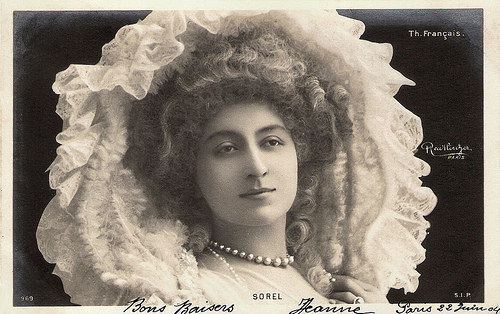
French postcard by S.I.P., no. 969. Sent by mail in 1904. Photo: Reutlinger, Paris.
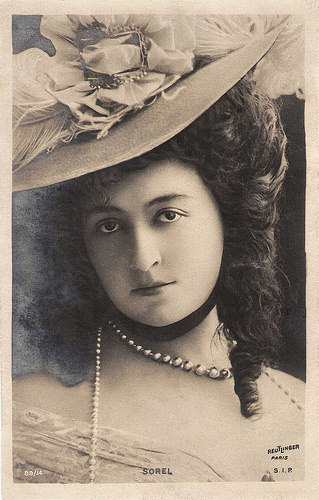
French postcard by S.I.P., no. 89/14. Photo: Reutlinger, Paris.
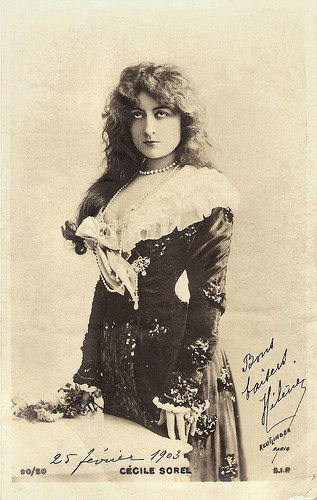
French postcard by S.I.P., no. 90/20. Sent by mail in 1903. Photo: Reutlinger, Paris.
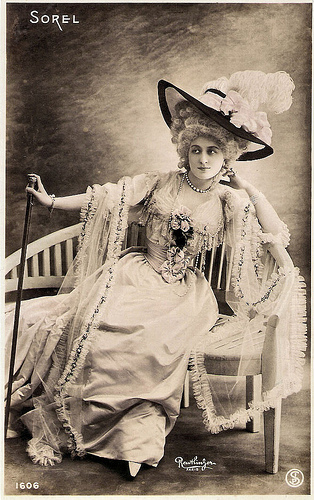
French postcard by S.I.P., no. 1606. Photo: Reutlinger, Paris.
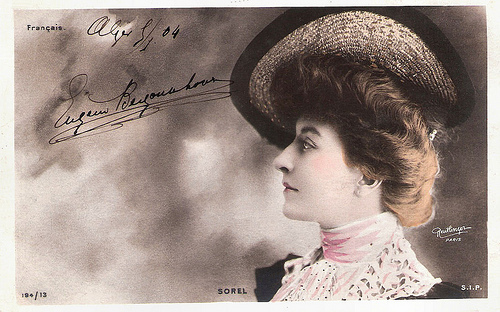
French postcard by S.I.P., no. 194/13. Photo: Reutlinger, Paris.
Grandes coquettes
Cécile Sorel was born as Céline Émilie Seurre in Paris in 1873. Very early, she was attracted by the theatre. She was a student of Delaunay and Mademoiselle Favart, and during the early years of her career, she played in a small boulevard theatre.
In 1899, she started to perform at the Odéon and in 1901, at the Comédie-Française, where she specialised in playing ‘grandes coquettes’. Her style was very recognisable and is now considered exaggerated, with her declamatory tone and articulated diction.
It was also the style of Sarah Bernhardt. Like the latter, she is particularly associated with the role of the courtesan Célimène in Le Misanthrope by Molière. Other success roles were La Dame aux camellias and Marion Delorme by Victor Hugo.
In 1904, she was elected 339th ‘Sociétaire’ (member) of the Comédie-Française, and Cécile Sorel would remain there until 1933. She enjoyed great popularity, and worked with some of the greatest personalities of her age, including Clemenceau, playwright Edmond Rostand (Cyrano de Bergerac) and actor Lucien Guitry (father of Sacha Guitry).
She performed on both sides of the Atlantic and was the eternal fiancee of Witney Warren, a wealthy American.
Eventually she married the somewhat younger Count de Segur Lamoignon, great-grand-son of the Countess de Segur, and a stage actor under the name of Guillaume de Sax. Although the count soon abandoned her for another woman, they never divorced. Sorel remained a ‘Countess’ all her life.
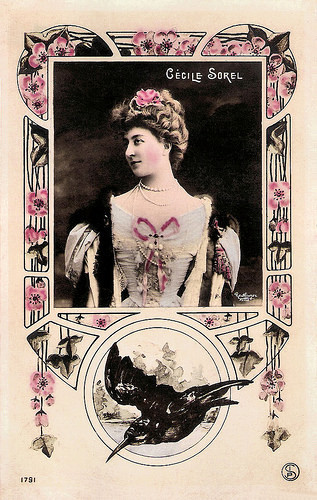
French postcard by S.I.P., no. 1791. Sent by mail in 1909. Photo: Reutlinger, Paris.
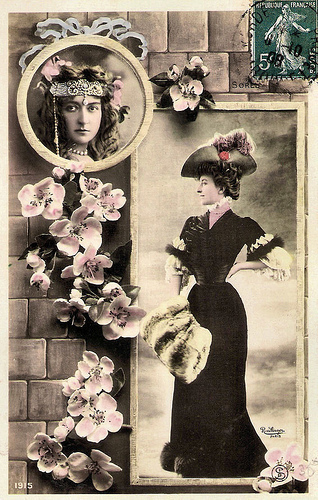
French postcard by S.I.P., no. 1915. Photo: Reutlinger, Paris. Sent by mail in 1908.
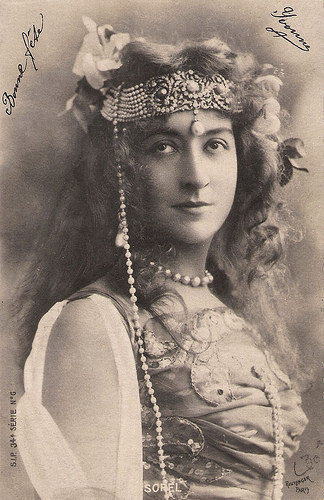
French postcard by S.I.P., series 34, no. 6. Photo: Reutlinger, Paris.
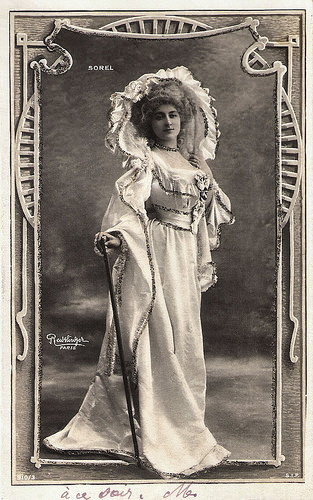
French postcard by S.I.P., no. 910/3. Photo: Reutlinger, Paris.
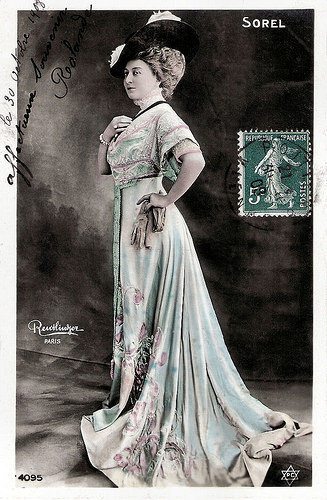
French postcard by PC, no. 4095. Photo: Reutlinger, Paris.
A revue star with feathers and glitter
From 1909 on, Cécile Sorel appeared incidentally in the cinema. She made her film debut in the silent short La Tosca (André Calmettes, Charles Le Bargy , 1909), a Film d’art production by Pathé Frères, based on the play by Victorien Sardou.
That year she appeared in another short silent film, Le crime à Zidore (Maurice de Féraudy, 1909) with Eugénie Noris.
In 1933 she left the classical theatre of the Comédie Française, and at the age of 60 she became a revue star with feathers and glitter at the Casino de Paris. That year she fell down the 45 stairs at the Casino and her simple remark "L'ai-je bien descendu? - Have I gone down well?" was widely quoted.
Nearly 30 years after her film debut, she returned to the cinema in Les perles de la couronne/The Pearls of the Crown (Sacha Guitry, 1937) in which she played a courtesan. The film tells the history of a set of perfectly matched pear-shaped pearls, that pass through many hands.
Her next film was L'an 40/The year 40 (Fernand Rivers, 1941) with André Alerme and Jules Berry . It is 1940 and the Germans have invaded France. A well off couple flees the invaders and gradually they lose all their material possessions but they discover the true meaning of life instead. The film premiered in Marseille at the Capitole Cinema on 31 January 1941, but the Vichy government banned it two days later and had all copies destroyed. None are known to have survived.
Her final film was the portmanteau film Les petits riens/Little Nothings (Raymond Leboursier, 1942) with Raimu and Fernandel .
In 1950 Cecile underwent a religious conversion, took monastic vows, and spent much of the remainder of her life in prayer and study.
Reputedly, she was one of the richest women in the world, owning several castles, yachts, Cécile Sorel passed away after a heart attack in 1966 château de Hennequeville in Trouville-sur-Mer, France. She was 92. She is buried at the Cimetière de Montparnasse.
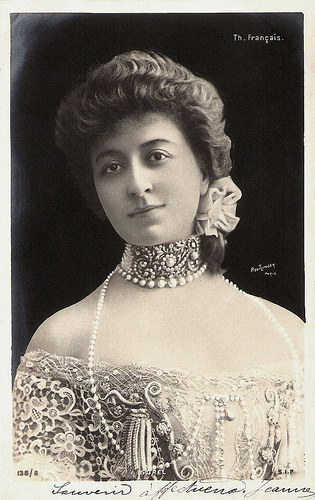
French postcard by S.I.P., no. 136/8. Photo: Reutlinger, Paris.
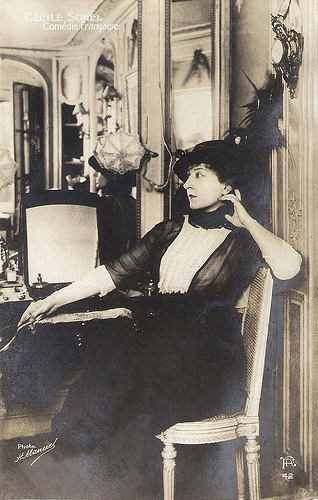
French postcard by F.A., no. 42. Photo: H. Manuel.
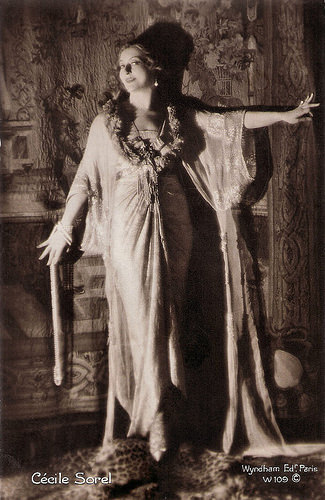
French postcard by Wyndham Ed., no. W 109.
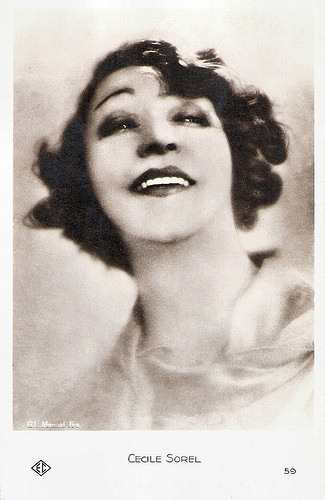
French postcard by E.C. (Editions Chantal), Paris, no. 59. Photo: G.L. Manuel Frères, Paris.
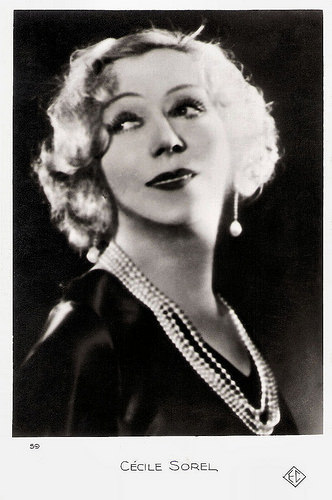
French postcard by EC (Editions Chantal), no. 59.
Sources: Bob Hufford (Find A Grave), Wikipedia (French) and .

French postcard by S.I.P., no. 969. Sent by mail in 1904. Photo: Reutlinger, Paris.

French postcard by S.I.P., no. 89/14. Photo: Reutlinger, Paris.

French postcard by S.I.P., no. 90/20. Sent by mail in 1903. Photo: Reutlinger, Paris.

French postcard by S.I.P., no. 1606. Photo: Reutlinger, Paris.

French postcard by S.I.P., no. 194/13. Photo: Reutlinger, Paris.
Grandes coquettes
Cécile Sorel was born as Céline Émilie Seurre in Paris in 1873. Very early, she was attracted by the theatre. She was a student of Delaunay and Mademoiselle Favart, and during the early years of her career, she played in a small boulevard theatre.
In 1899, she started to perform at the Odéon and in 1901, at the Comédie-Française, where she specialised in playing ‘grandes coquettes’. Her style was very recognisable and is now considered exaggerated, with her declamatory tone and articulated diction.
It was also the style of Sarah Bernhardt. Like the latter, she is particularly associated with the role of the courtesan Célimène in Le Misanthrope by Molière. Other success roles were La Dame aux camellias and Marion Delorme by Victor Hugo.
In 1904, she was elected 339th ‘Sociétaire’ (member) of the Comédie-Française, and Cécile Sorel would remain there until 1933. She enjoyed great popularity, and worked with some of the greatest personalities of her age, including Clemenceau, playwright Edmond Rostand (Cyrano de Bergerac) and actor Lucien Guitry (father of Sacha Guitry).
She performed on both sides of the Atlantic and was the eternal fiancee of Witney Warren, a wealthy American.
Eventually she married the somewhat younger Count de Segur Lamoignon, great-grand-son of the Countess de Segur, and a stage actor under the name of Guillaume de Sax. Although the count soon abandoned her for another woman, they never divorced. Sorel remained a ‘Countess’ all her life.

French postcard by S.I.P., no. 1791. Sent by mail in 1909. Photo: Reutlinger, Paris.

French postcard by S.I.P., no. 1915. Photo: Reutlinger, Paris. Sent by mail in 1908.

French postcard by S.I.P., series 34, no. 6. Photo: Reutlinger, Paris.

French postcard by S.I.P., no. 910/3. Photo: Reutlinger, Paris.

French postcard by PC, no. 4095. Photo: Reutlinger, Paris.
A revue star with feathers and glitter
From 1909 on, Cécile Sorel appeared incidentally in the cinema. She made her film debut in the silent short La Tosca (André Calmettes, Charles Le Bargy , 1909), a Film d’art production by Pathé Frères, based on the play by Victorien Sardou.
That year she appeared in another short silent film, Le crime à Zidore (Maurice de Féraudy, 1909) with Eugénie Noris.
In 1933 she left the classical theatre of the Comédie Française, and at the age of 60 she became a revue star with feathers and glitter at the Casino de Paris. That year she fell down the 45 stairs at the Casino and her simple remark "L'ai-je bien descendu? - Have I gone down well?" was widely quoted.
Nearly 30 years after her film debut, she returned to the cinema in Les perles de la couronne/The Pearls of the Crown (Sacha Guitry, 1937) in which she played a courtesan. The film tells the history of a set of perfectly matched pear-shaped pearls, that pass through many hands.
Her next film was L'an 40/The year 40 (Fernand Rivers, 1941) with André Alerme and Jules Berry . It is 1940 and the Germans have invaded France. A well off couple flees the invaders and gradually they lose all their material possessions but they discover the true meaning of life instead. The film premiered in Marseille at the Capitole Cinema on 31 January 1941, but the Vichy government banned it two days later and had all copies destroyed. None are known to have survived.
Her final film was the portmanteau film Les petits riens/Little Nothings (Raymond Leboursier, 1942) with Raimu and Fernandel .
In 1950 Cecile underwent a religious conversion, took monastic vows, and spent much of the remainder of her life in prayer and study.
Reputedly, she was one of the richest women in the world, owning several castles, yachts, Cécile Sorel passed away after a heart attack in 1966 château de Hennequeville in Trouville-sur-Mer, France. She was 92. She is buried at the Cimetière de Montparnasse.

French postcard by S.I.P., no. 136/8. Photo: Reutlinger, Paris.

French postcard by F.A., no. 42. Photo: H. Manuel.

French postcard by Wyndham Ed., no. W 109.

French postcard by E.C. (Editions Chantal), Paris, no. 59. Photo: G.L. Manuel Frères, Paris.

French postcard by EC (Editions Chantal), no. 59.
Sources: Bob Hufford (Find A Grave), Wikipedia (French) and .
Published on October 12, 2014 23:00
October 11, 2014
Rare postcards from the Cinema of the Russian Empire
Yesterday, collector Didier Hanson sent me these scans of Russian film postcards from the pre-Soviet era. I liked them so much that I wanted to present them today to you. So, here are incredibly rare postcards of silent stars like Vera Karalli, Nathalie Kovanko, Vitold Polonsky, Ossip Runitsch, Vladimir Maximov and of course the greatest Russian diva of that era, Vera Kholodnaya. Thanks for sharing, Didier!
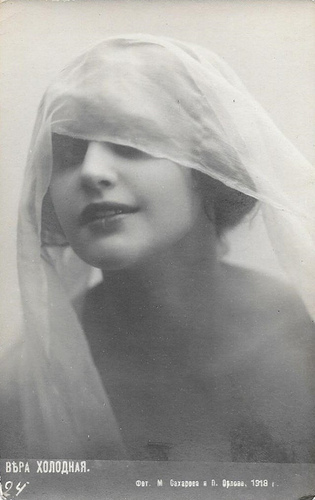
Vera Kholodnaya . Russian postcard, no. 24, 1918. Collection: Didier Hanson.
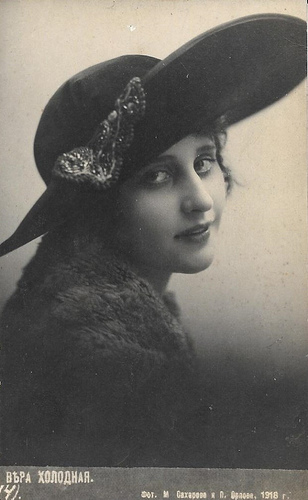
Vera Kholodnaya . Russian postcard, no. 141, 1918. Collection: Didier Hanson.
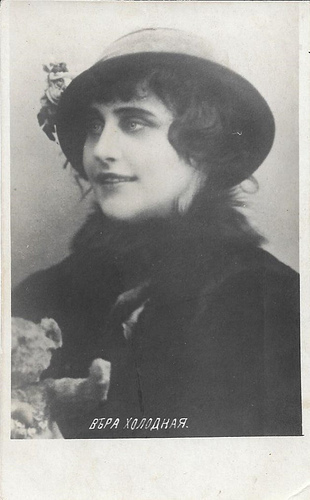
Vera Kholodnaya . Russian postcard, no. 30. Collection: Didier Hanson.
A Strong Infrastructure
The Cinema of the Russian Empire roughly spans the period 1907-1920, during which time a strong infrastructure was created. From the over 2,700 art films created in Russia before 1920, around 300 remain to this day.
In 1908, Alexander Drankov produced the first Russian narrative film, Stenka Razin, based on events told in a popular folk song and directed by Vladimir Romashkov.
At the same time, the Moscow cinema entrepreneur Aleksandr Khanzhonkov began to operate. In 1912, the Khanzhonkov film studio was operational.
The same year, a German concern filming in Russia introduced the director Yakov Protazanov to the world with its Ukhod Velikovo Startsa/Departure of the Grand Old Man, a biographical film about Lev Tolstoy.
From 1911 to 1914 Ivan Mozzhukhin worked in the silent films of Khanzhonkov.
Mozzhukhin shot to fame after his leading role as violinist Trukhachevsky in Kreitzerova sonata/The Kreutzer Sonata (Pyotr Chardynin, 1911), based on the eponymous story by Leo Tolstoy.
He starred as Admiral Kornilov in Oborona Sevastopolya/Defence of Sevastopol (Vasili Goncharov, Aleksandr Khanzhonkov, 1911), a feature film of 2000 meters. This was the first film ever that was shot by two cameras.
Next he appeared in the delightful comedy Domik v Kolomne/The Kolomna House (Pyotr Chardynin, 1913) after a poem by Alexander Pushkin.
By the mid-1910s Ivan Mozzhukhin had become the most important male star of the Cinema of the Russian Empire.
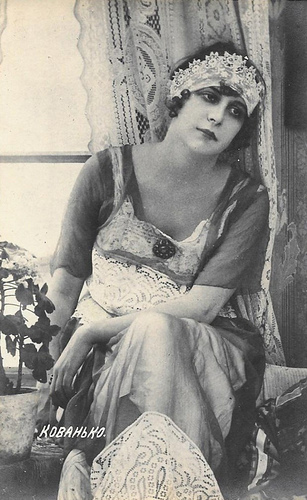
Nathalie Kovanko . Russian postcard. Collection: Didier Hanson.
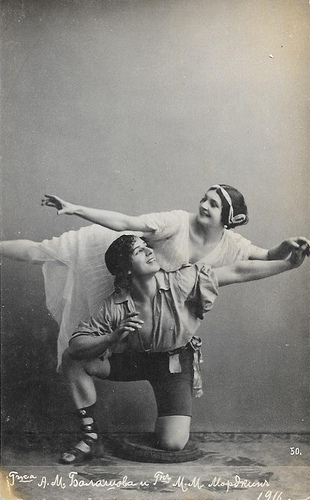
Alexandra Balashova and Mikhail Mortkin. Russian postcard, no. 30. Collection: Didier Hanson.
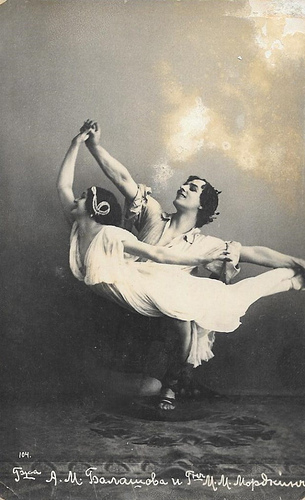
Alexandra Balashova and Mikhail Mortkin. Russian postcard, no. 144. Collection: Didier Hanson.
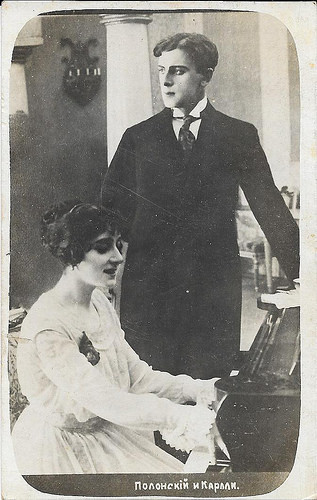
Vitold Polonsky and Vera Karalli . Russian postcard. Collection: Didier Hanson. Photo: publicity still for Vozmezdie/Retribution (Yevgeni Bauer, 1916).
Change
The arrival of World War I in Russia in 1914 sparked a change in the Cinema of the Russian Empire.
In 1916, Russia produced 499 films, over three times the number of just three years earlier, and more of feature length.
Russia's war allies began to import some of the more striking product, including films by Yakov Protazanov and Yevgeni Bauer, a specialist in psychological film, who both impacted, among others, the burgeoning American film industry.
And then came the Russian Revolution. With audiences turning against the Tsar, film producers began turning out, after the February Revolution, a number of films with anti-Tsarist themes. These, along with the usual retinue of detective films and melodramas, filled theatres.
The destruction of the infrastructure in the major cities, the failing war-drained economy, the takeover of rural cinemas by local Soviets, and the aversion of some in the film industry to communism, caused the Russian film industry per se to effectively die out by the time Lenin on 8 November 1917 proclaimed a new country, the Russian Soviet Federative Socialist Republic.
The last significant Russian film completed, Otets Sergiy/Father Sergius (Yakov Protazanov, Alexandre Volkoff, 1917) featuring Ivan Mozzhukhin would become the first new film release a year later, in the new country of the Soviets.
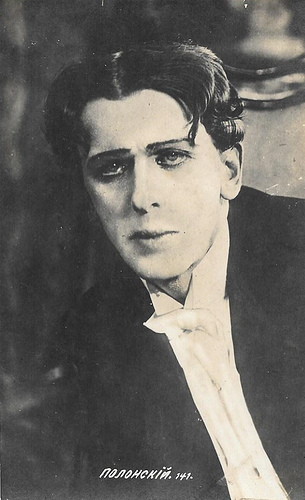
Vitold Polonsky, no. 141. Russian postcard. Collection: Didier Hanson.
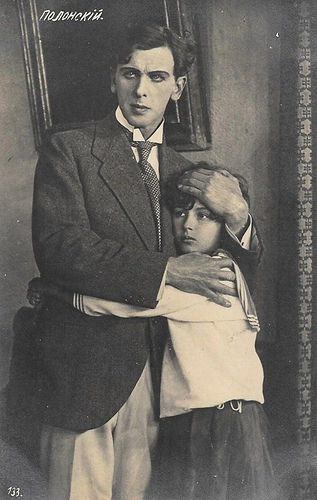
Vitold Polonsky. Russian postcard, no. 133. Collection: Didier Hanson.
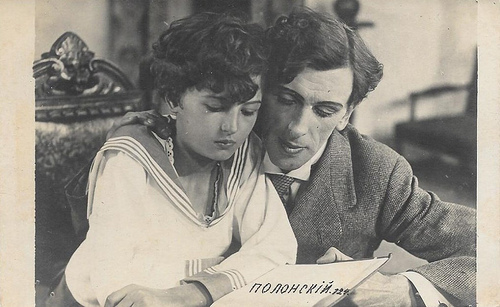
Vitold Polonsky. Russian postcard, no. 124. Collection: Didier Hanson.
Vera Kholodnaya
One of the first stars of the Cinema of the Russian Empire was Vera Kholodnaya (1893-1919).
Her film debut was a minor role in a grand production of Anna Karenina (Vladimir Gardin, 1914) with Mariya Germanova in the title role.
Then director Yevgeni Bauer was looking for a woman of outstanding beauty for a new film. When Kholodnaya was introduced to him, Bauer reportedly was spellbound of the small, intense woman with her commanding grey eyes and mop of black hair.
Bauer at once approved her for the part, the lead role in the Ivan Turgenev adaptation Pesn torzhestvuyushchey lyubvi/The Song of the Triumphant Love (Yevgeni Bauer, 1915).
This mystical love drama was a major box-office hit, and she signed a three-years contract with the Khanzhonkov studio. The impatient Bauer immediately made another film with his new discovery, Plamya Neba/Flame of the Sky (Yevgeni Bauer, 1915).
Four years later, the ‘Queen of the Screen’ died of the Spanish flu during the pandemic of 1919.
There were also rumours about a Mata Hari-like intrigue. Her death should be attributed to poisoning following a love story with the Spanish Ambassador...
Although the 26-years old actress had worked only three years for the cinema, she must have made between fifty and hundred short films.
The Soviet authorities ordered to destroy many of the Kholodnaya features in 1924, and only five of her films still exist.
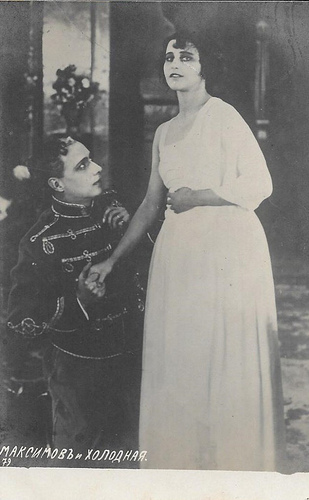
Vera Kholodnaya and Vladimir Maximov . Russian postcard, no. 79. Collection: Didier Hanson.
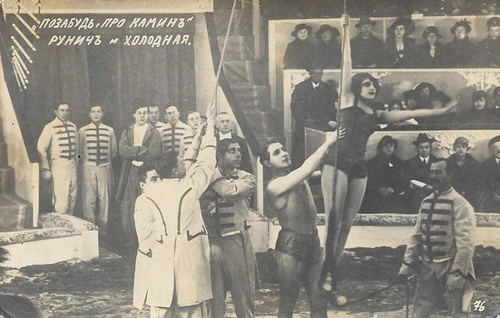
Vera Kholodnaya and Ossip Runitsch . Russian postcard, no. 30. Collection: Didier Hanson.
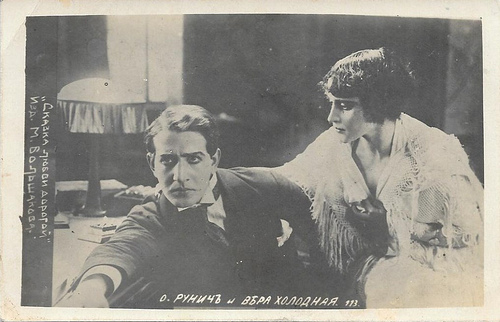
Vera Kholodnaya and Ossip Runitsch . Russian postcard, no. 173. Collection: Didier Hanson.
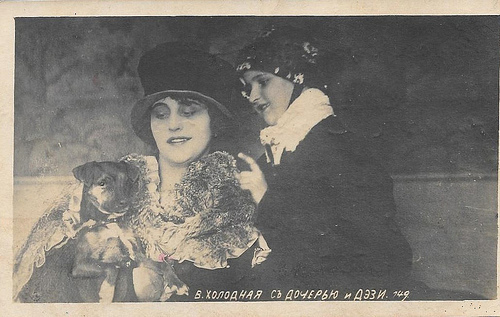
Vera Kholodnaya . Russian postcard, no. 149. Collection: Didier Hanson.
Sources: Wikipedia and .

Vera Kholodnaya . Russian postcard, no. 24, 1918. Collection: Didier Hanson.

Vera Kholodnaya . Russian postcard, no. 141, 1918. Collection: Didier Hanson.

Vera Kholodnaya . Russian postcard, no. 30. Collection: Didier Hanson.
A Strong Infrastructure
The Cinema of the Russian Empire roughly spans the period 1907-1920, during which time a strong infrastructure was created. From the over 2,700 art films created in Russia before 1920, around 300 remain to this day.
In 1908, Alexander Drankov produced the first Russian narrative film, Stenka Razin, based on events told in a popular folk song and directed by Vladimir Romashkov.
At the same time, the Moscow cinema entrepreneur Aleksandr Khanzhonkov began to operate. In 1912, the Khanzhonkov film studio was operational.
The same year, a German concern filming in Russia introduced the director Yakov Protazanov to the world with its Ukhod Velikovo Startsa/Departure of the Grand Old Man, a biographical film about Lev Tolstoy.
From 1911 to 1914 Ivan Mozzhukhin worked in the silent films of Khanzhonkov.
Mozzhukhin shot to fame after his leading role as violinist Trukhachevsky in Kreitzerova sonata/The Kreutzer Sonata (Pyotr Chardynin, 1911), based on the eponymous story by Leo Tolstoy.
He starred as Admiral Kornilov in Oborona Sevastopolya/Defence of Sevastopol (Vasili Goncharov, Aleksandr Khanzhonkov, 1911), a feature film of 2000 meters. This was the first film ever that was shot by two cameras.
Next he appeared in the delightful comedy Domik v Kolomne/The Kolomna House (Pyotr Chardynin, 1913) after a poem by Alexander Pushkin.
By the mid-1910s Ivan Mozzhukhin had become the most important male star of the Cinema of the Russian Empire.

Nathalie Kovanko . Russian postcard. Collection: Didier Hanson.

Alexandra Balashova and Mikhail Mortkin. Russian postcard, no. 30. Collection: Didier Hanson.

Alexandra Balashova and Mikhail Mortkin. Russian postcard, no. 144. Collection: Didier Hanson.

Vitold Polonsky and Vera Karalli . Russian postcard. Collection: Didier Hanson. Photo: publicity still for Vozmezdie/Retribution (Yevgeni Bauer, 1916).
Change
The arrival of World War I in Russia in 1914 sparked a change in the Cinema of the Russian Empire.
In 1916, Russia produced 499 films, over three times the number of just three years earlier, and more of feature length.
Russia's war allies began to import some of the more striking product, including films by Yakov Protazanov and Yevgeni Bauer, a specialist in psychological film, who both impacted, among others, the burgeoning American film industry.
And then came the Russian Revolution. With audiences turning against the Tsar, film producers began turning out, after the February Revolution, a number of films with anti-Tsarist themes. These, along with the usual retinue of detective films and melodramas, filled theatres.
The destruction of the infrastructure in the major cities, the failing war-drained economy, the takeover of rural cinemas by local Soviets, and the aversion of some in the film industry to communism, caused the Russian film industry per se to effectively die out by the time Lenin on 8 November 1917 proclaimed a new country, the Russian Soviet Federative Socialist Republic.
The last significant Russian film completed, Otets Sergiy/Father Sergius (Yakov Protazanov, Alexandre Volkoff, 1917) featuring Ivan Mozzhukhin would become the first new film release a year later, in the new country of the Soviets.

Vitold Polonsky, no. 141. Russian postcard. Collection: Didier Hanson.

Vitold Polonsky. Russian postcard, no. 133. Collection: Didier Hanson.

Vitold Polonsky. Russian postcard, no. 124. Collection: Didier Hanson.
Vera Kholodnaya
One of the first stars of the Cinema of the Russian Empire was Vera Kholodnaya (1893-1919).
Her film debut was a minor role in a grand production of Anna Karenina (Vladimir Gardin, 1914) with Mariya Germanova in the title role.
Then director Yevgeni Bauer was looking for a woman of outstanding beauty for a new film. When Kholodnaya was introduced to him, Bauer reportedly was spellbound of the small, intense woman with her commanding grey eyes and mop of black hair.
Bauer at once approved her for the part, the lead role in the Ivan Turgenev adaptation Pesn torzhestvuyushchey lyubvi/The Song of the Triumphant Love (Yevgeni Bauer, 1915).
This mystical love drama was a major box-office hit, and she signed a three-years contract with the Khanzhonkov studio. The impatient Bauer immediately made another film with his new discovery, Plamya Neba/Flame of the Sky (Yevgeni Bauer, 1915).
Four years later, the ‘Queen of the Screen’ died of the Spanish flu during the pandemic of 1919.
There were also rumours about a Mata Hari-like intrigue. Her death should be attributed to poisoning following a love story with the Spanish Ambassador...
Although the 26-years old actress had worked only three years for the cinema, she must have made between fifty and hundred short films.
The Soviet authorities ordered to destroy many of the Kholodnaya features in 1924, and only five of her films still exist.

Vera Kholodnaya and Vladimir Maximov . Russian postcard, no. 79. Collection: Didier Hanson.

Vera Kholodnaya and Ossip Runitsch . Russian postcard, no. 30. Collection: Didier Hanson.

Vera Kholodnaya and Ossip Runitsch . Russian postcard, no. 173. Collection: Didier Hanson.

Vera Kholodnaya . Russian postcard, no. 149. Collection: Didier Hanson.
Sources: Wikipedia and .
Published on October 11, 2014 22:00
Paul van Yperen's Blog
- Paul van Yperen's profile
- 13 followers
Paul van Yperen isn't a Goodreads Author
(yet),
but they
do have a blog,
so here are some recent posts imported from
their feed.



